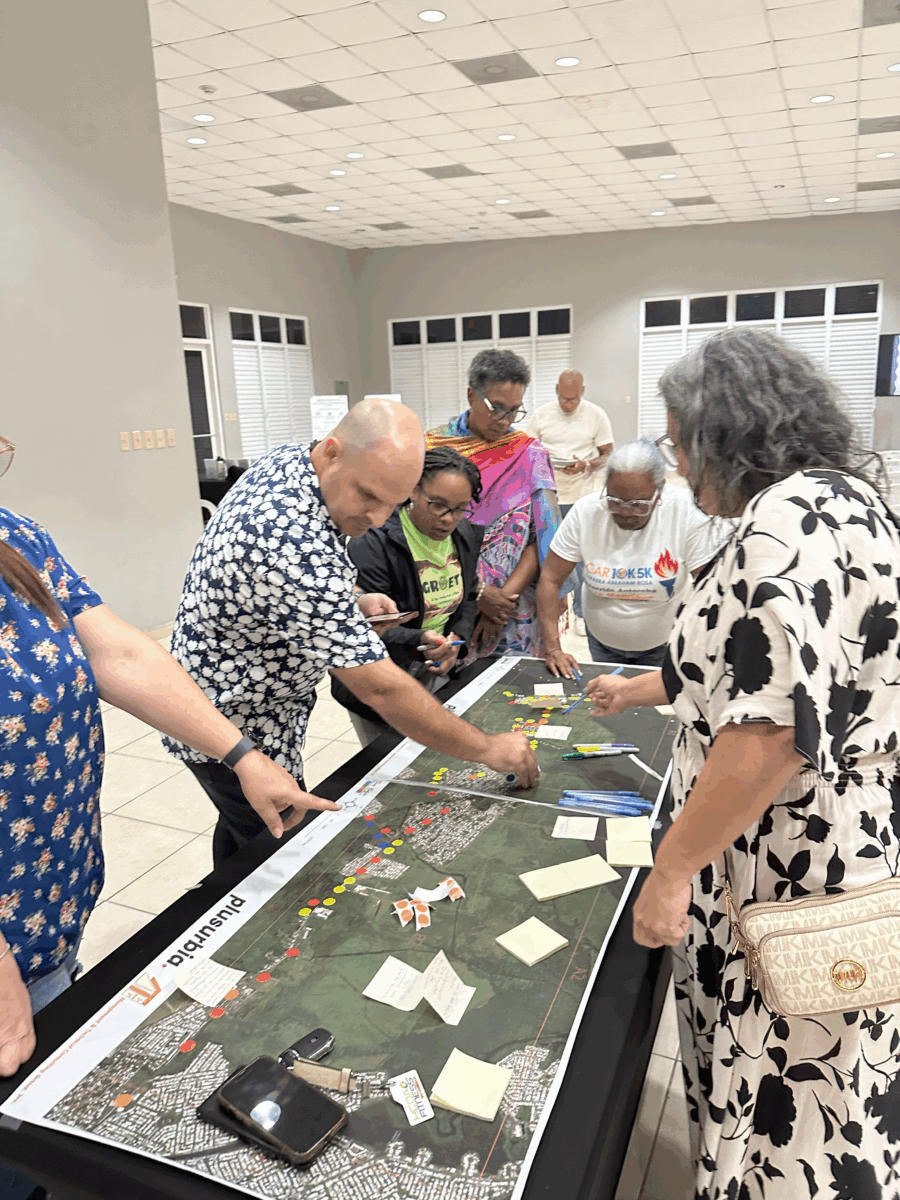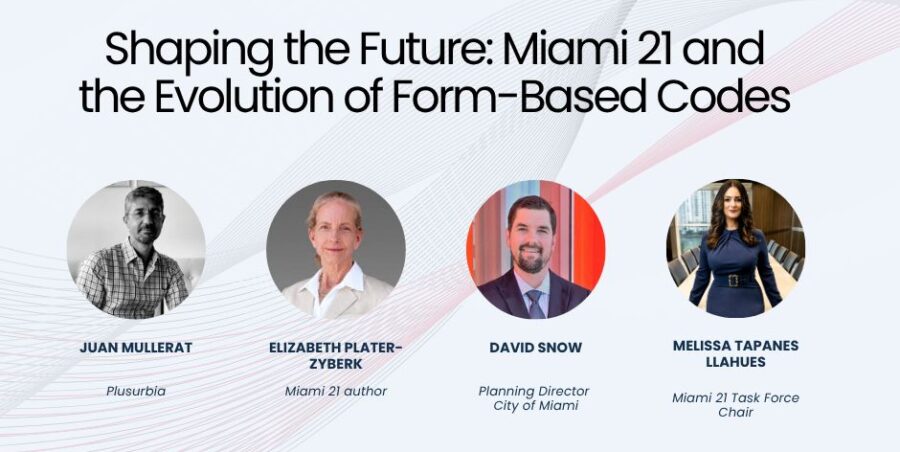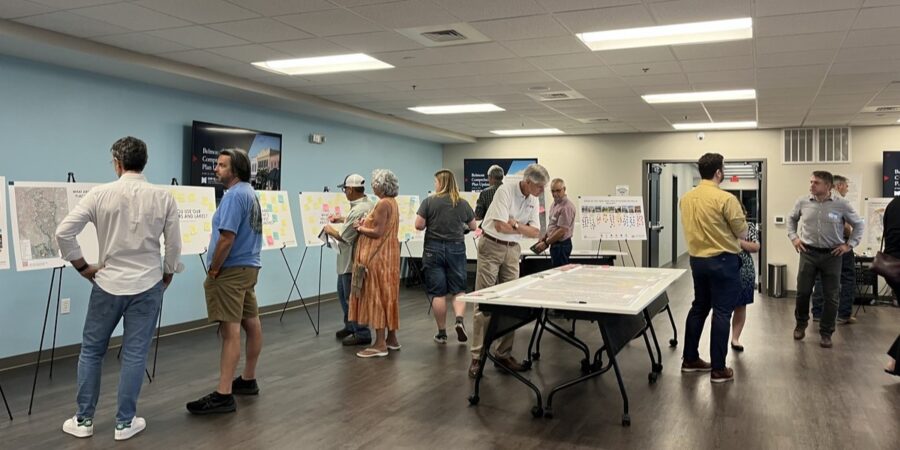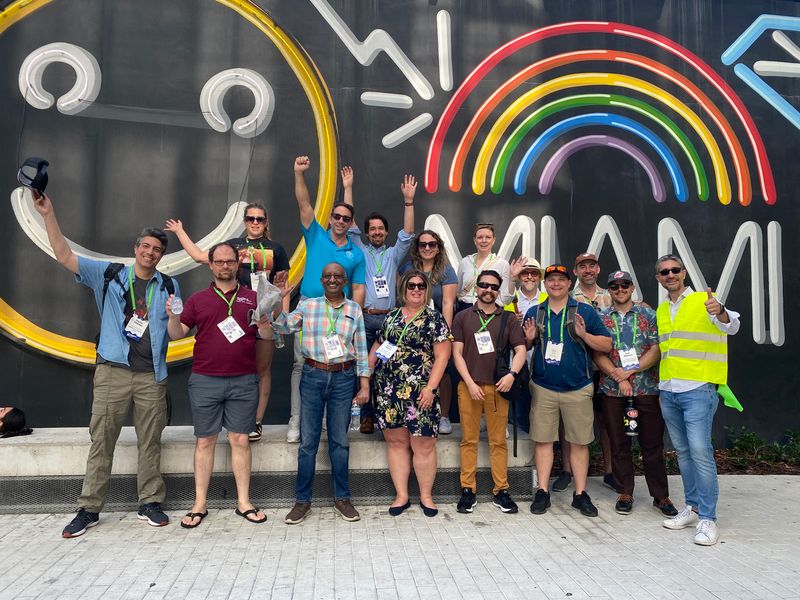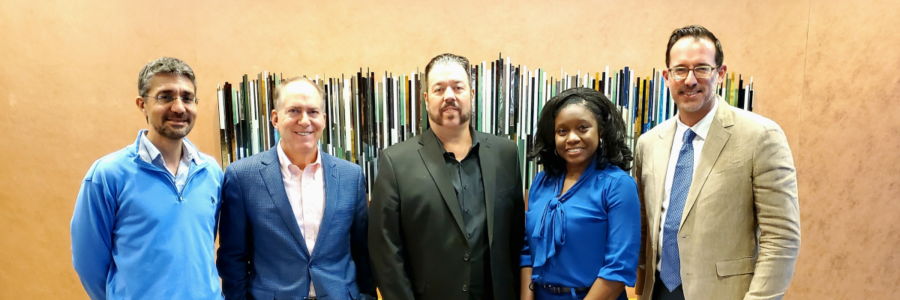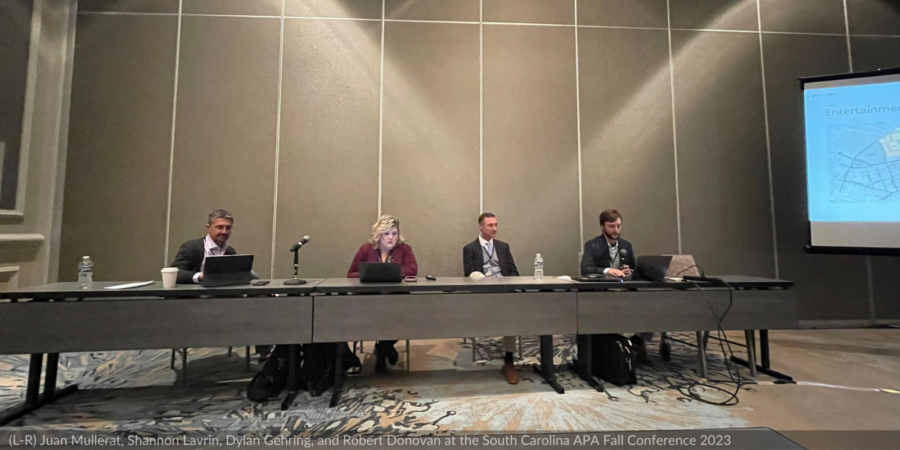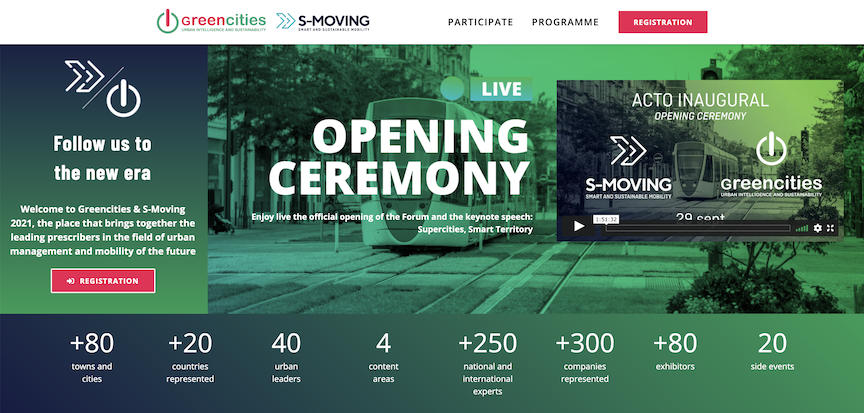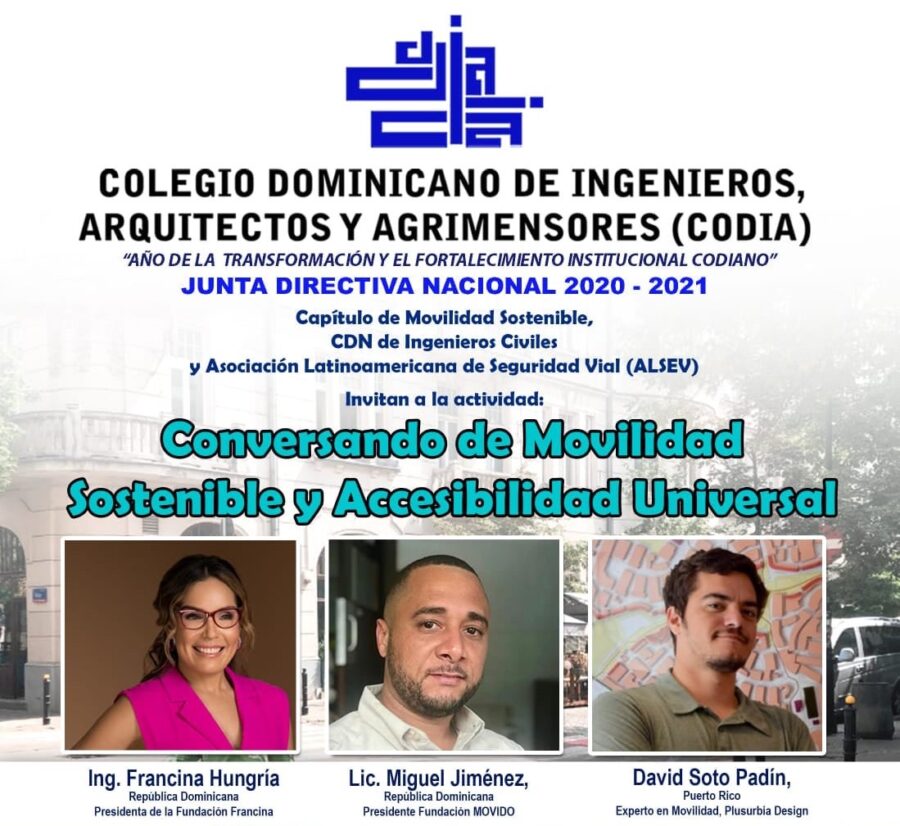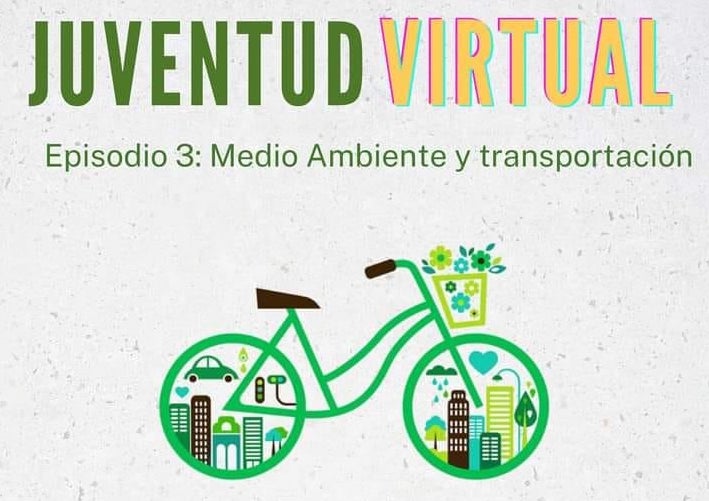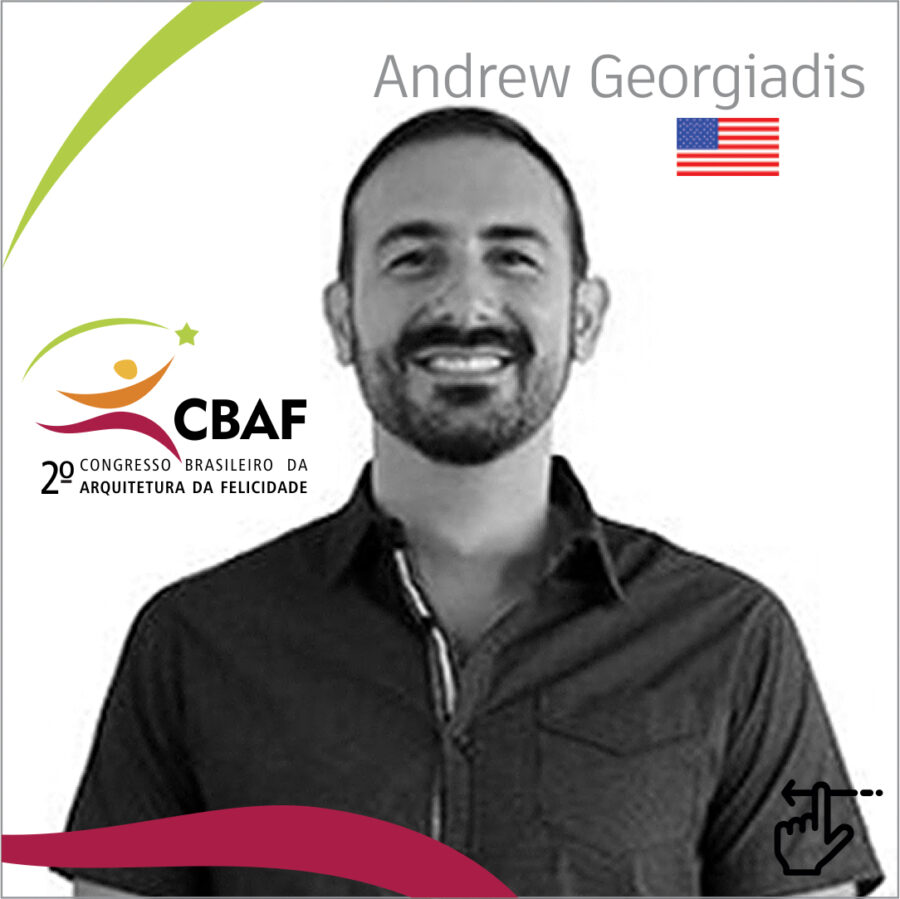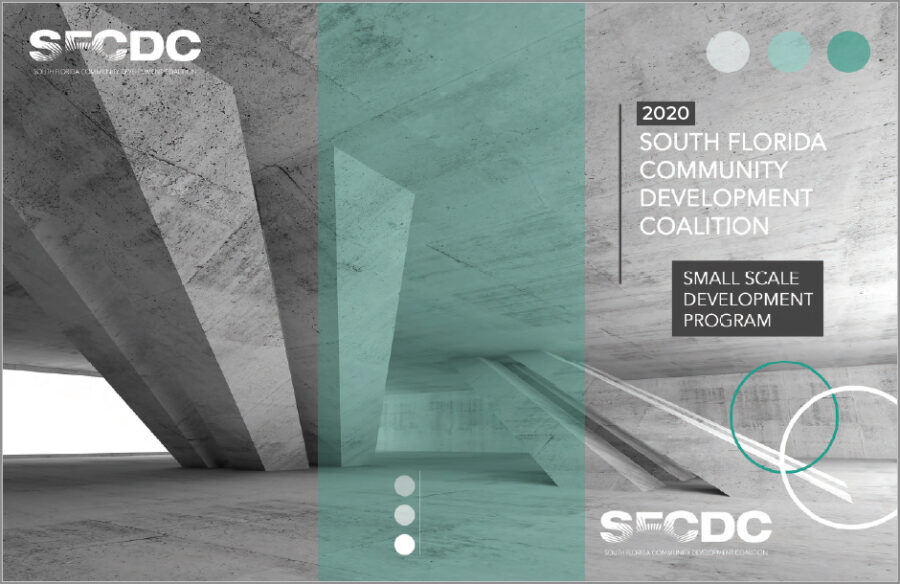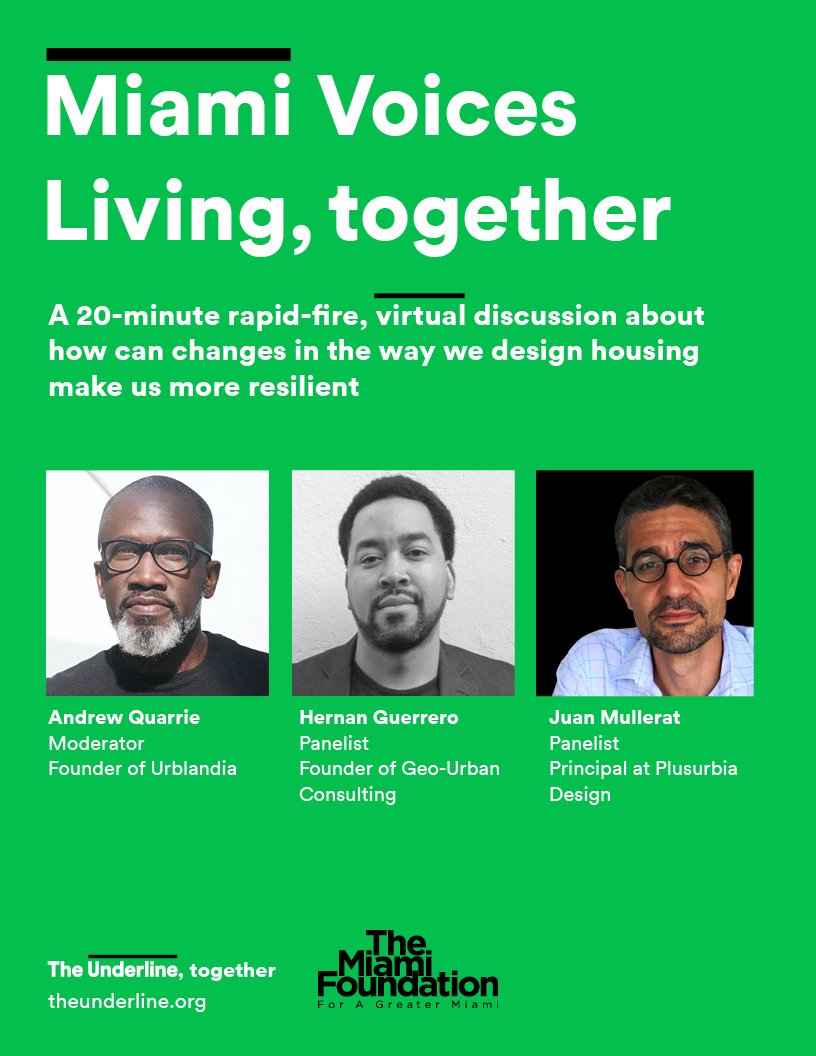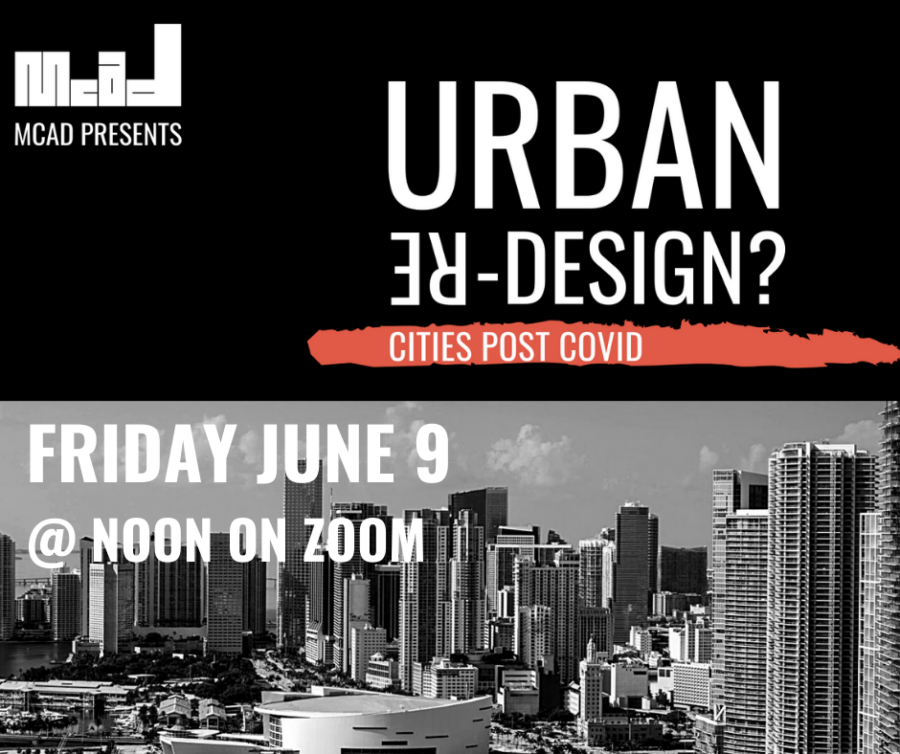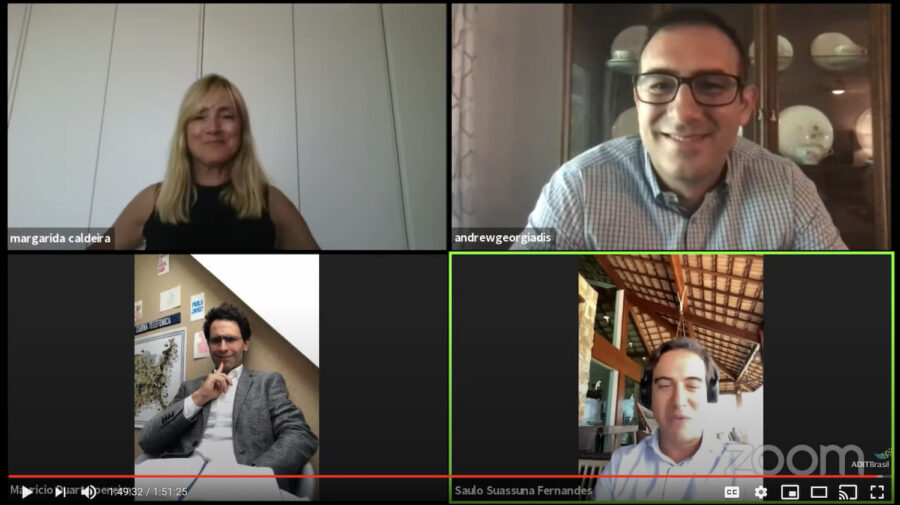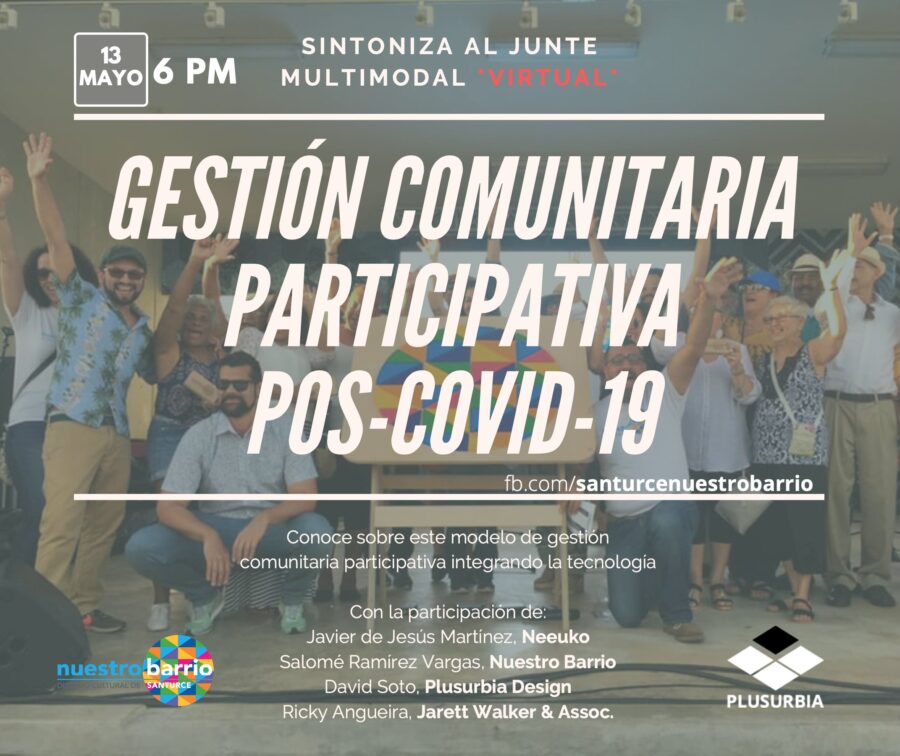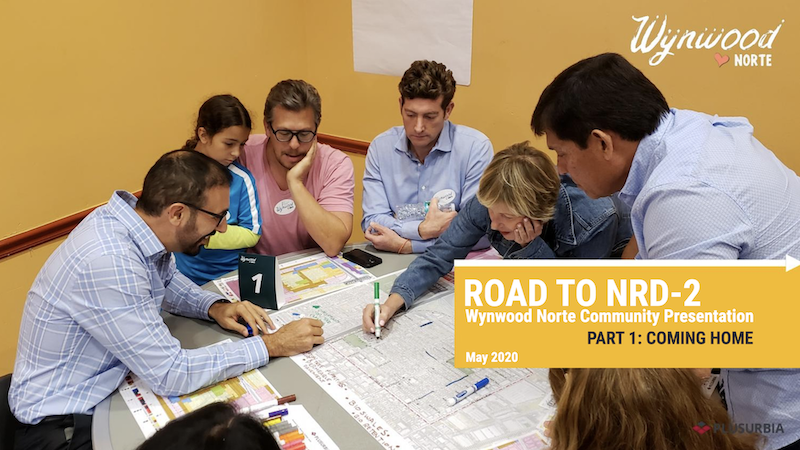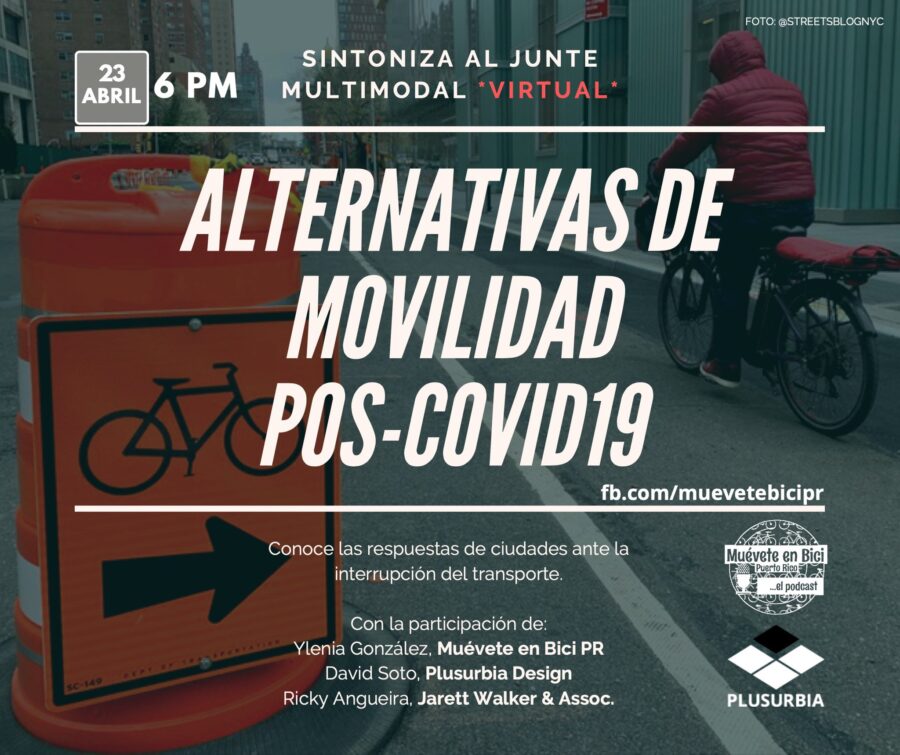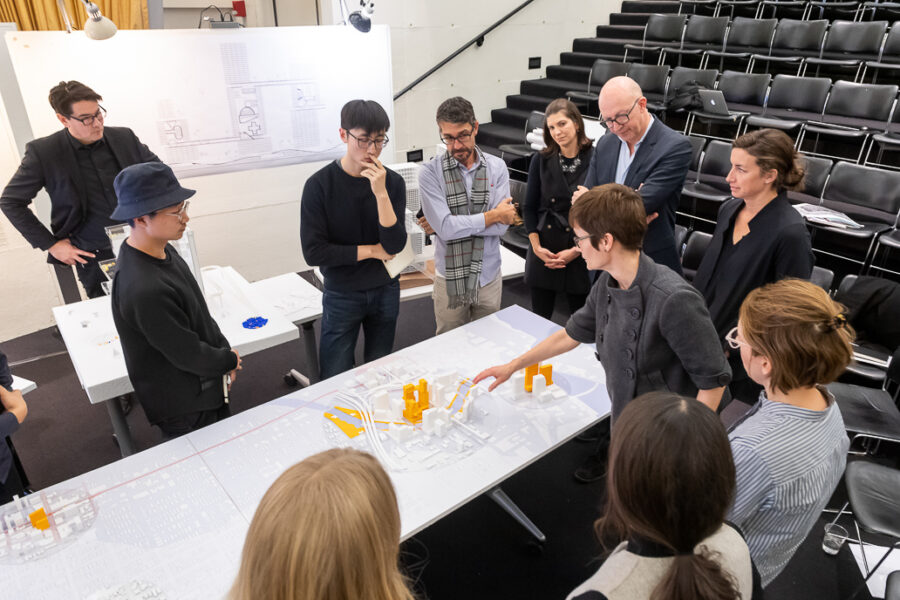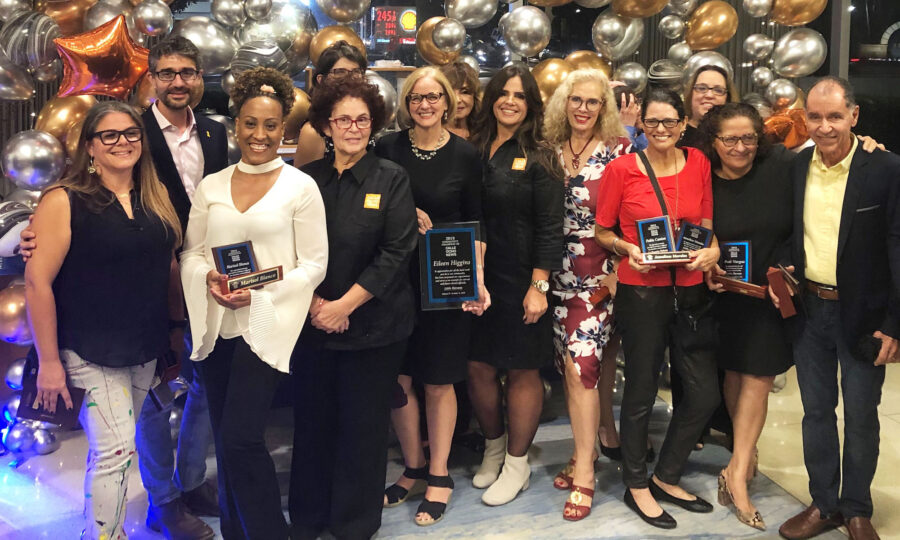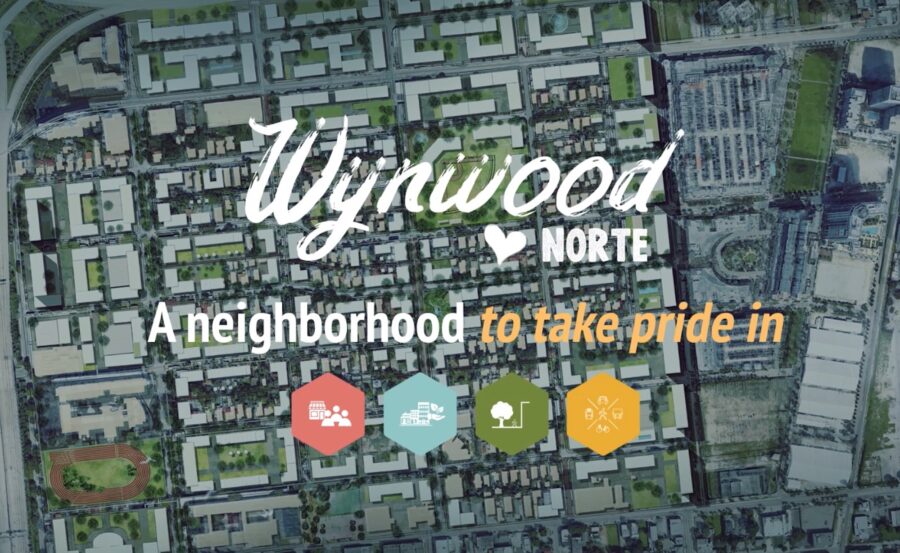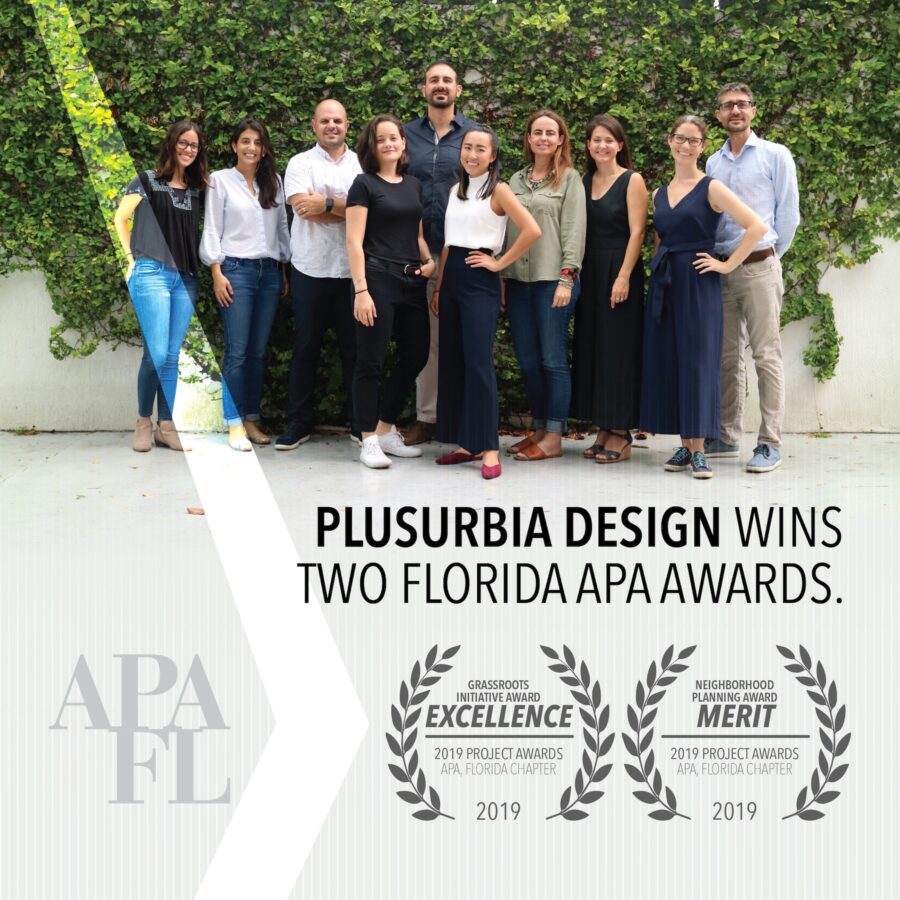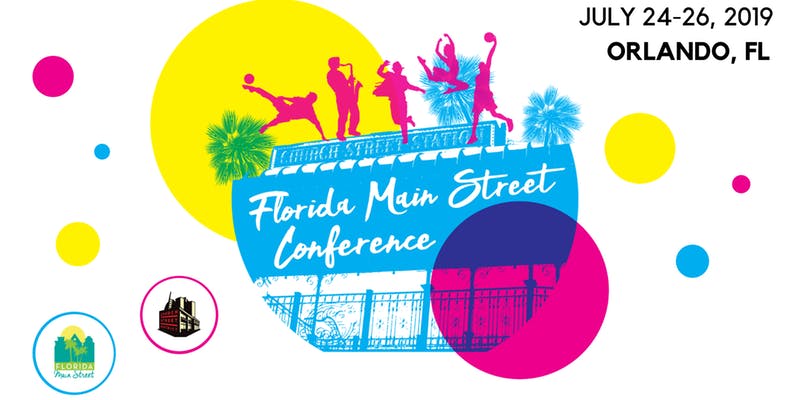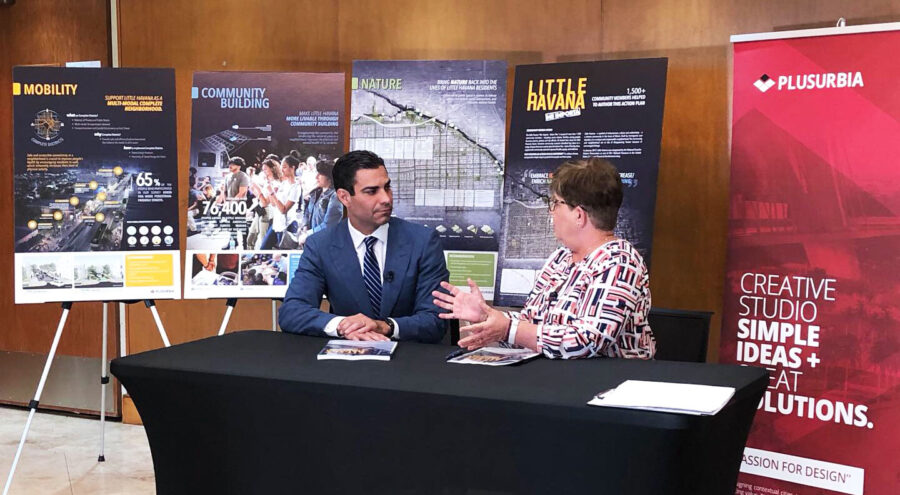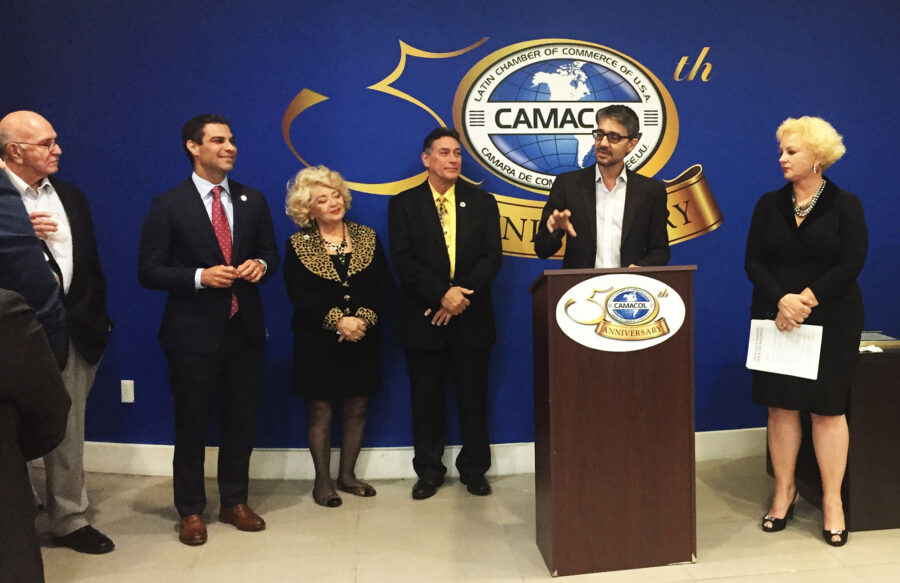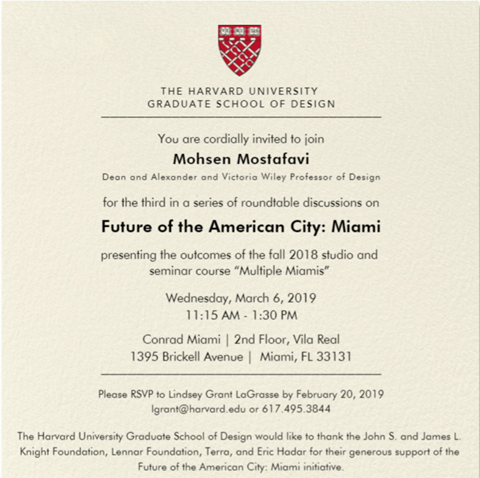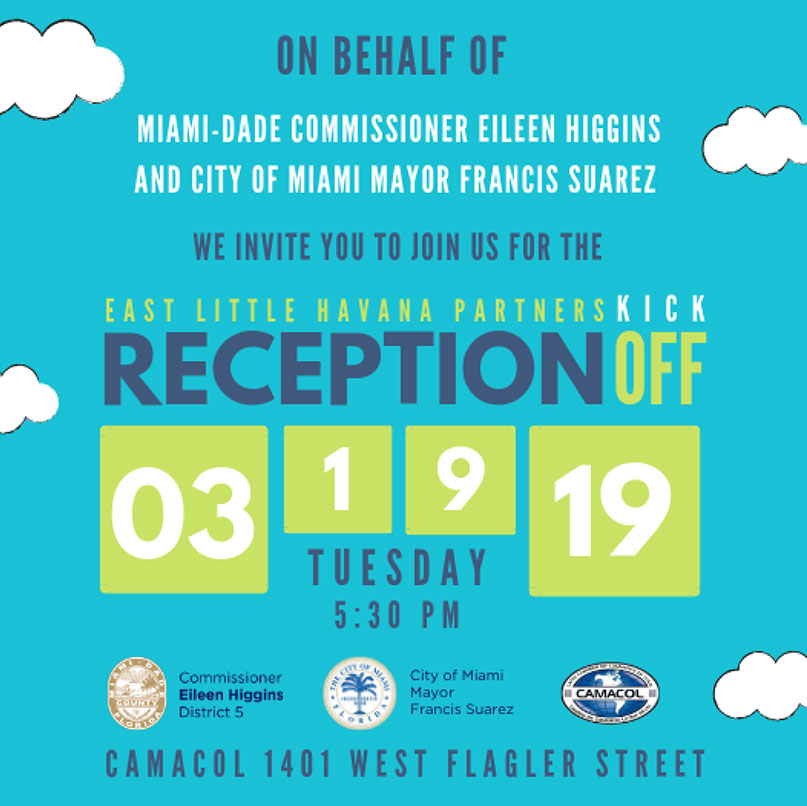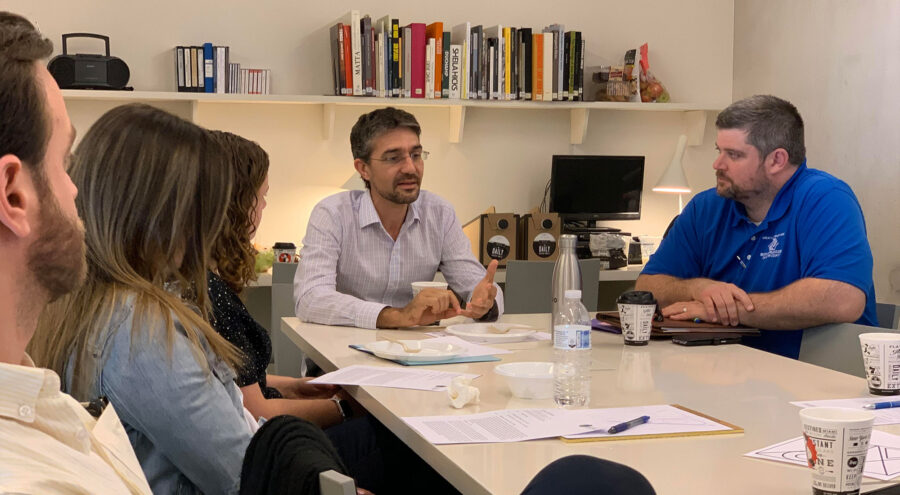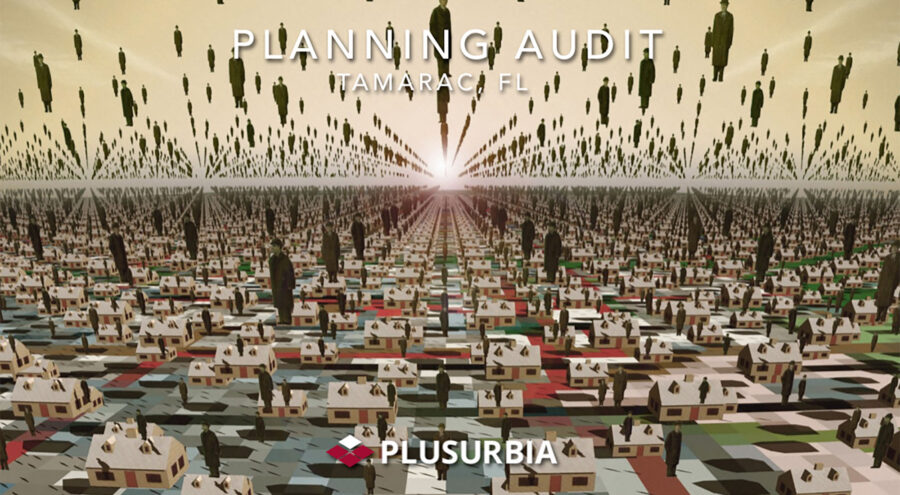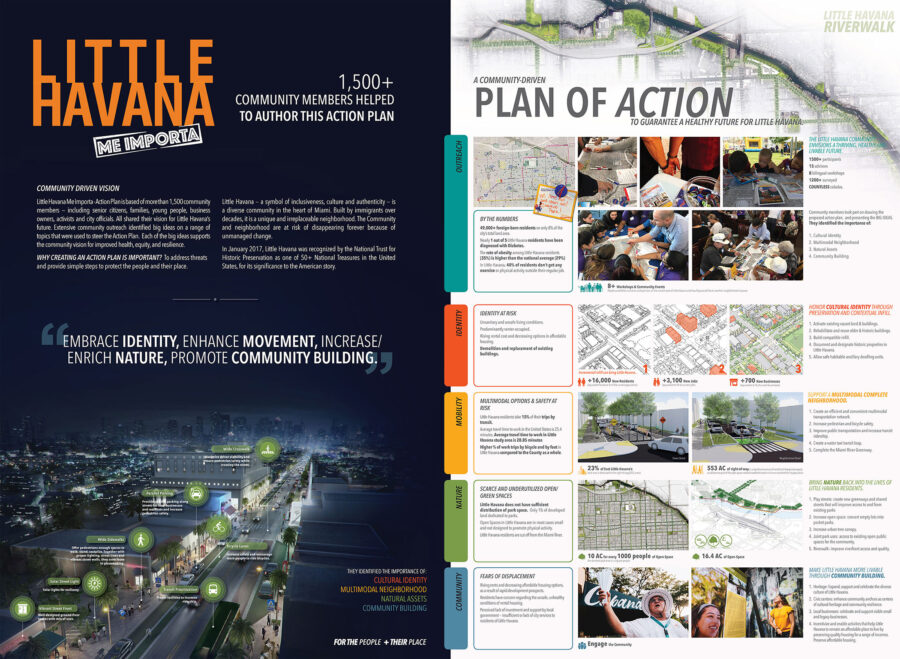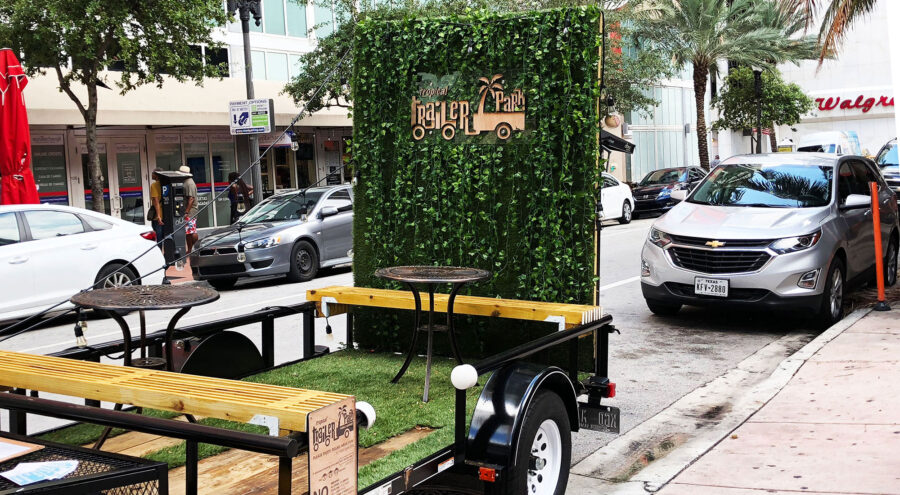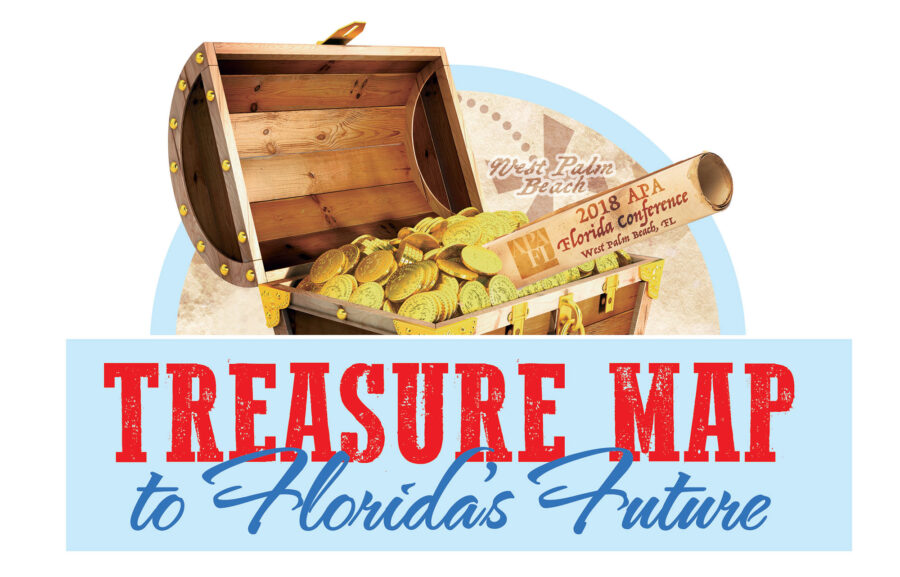our
news
AWARDS, ACCOLADES, PUBLICATIONS AND NEWS.
TOA BAJA, PR — August 2025 — Community Engagement in Full Swing! ❤️
Our team in Puerto Rico has successfully completed the first four community meetings as part of the Toa Baja Safety Action Plan—and the momentum continues to build. With four additional sessions planned, community engagement remains at the heart of this initiative.
We’re honored and inspired by the enthusiastic participation of residents and local stakeholders who are deeply committed to creating safer streets. Their insights, lived experiences, and thoughtful recommendations are shaping a plan that truly reflects the community’s priorities.These meetings represent a key step toward building a collaborative vision for safer, more accessible neighborhoods. At Plusurbia, we believe meaningful change begins with listening—and the voices of the community have been clear and impactful.Thank you to everyone who has taken part in the process so far. Your input is the foundation of this effort, and we’re excited to continue working together to create safer, more connected communities.Scroll down for highlights from the events![gallery size="medium" columns="2" link="file" ids="28647,28646,28645,28644,28638,28641,28642,28643"]
Adopted in 2010, Miami 21 was the first form-based zoning code applied to a large U.S. city. It replaced outdated, car-centric regulations with a framework prioritizing walkability, mixed-use development, and cohesive neighborhood design. Miami 21 has since become a reference point for cities across the country exploring New Urbanism principles to guide growth in the 21st century.
Juan Mullerat, Principal of Plusurbia, has long championed zoning as a tool for equity, resilience, and livability. joined a distinguished panel with Lizz Plater-Zyberk, Code author David Snow, City of Miami's Planning Director, and Melissa Tapanes Llahues, Land Use Attorney, to reflect on Miami 21’s legacy, its evolving role in shaping the built environment, and what’s next for cities embracing form-based codes.
The discussion examined how Miami 21 has influenced urban design, transportation, housing, and public spaces over the past 15 years, while also looking ahead to the evolving needs of a dynamic and growing city.
Watch the full panel discussion here:
Dade Heritage Trust (DHT) proudly announces the launch of its new podcast, "Miami Preserves." This podcast, produced in collaboration with DHT’s Historic Places, Green Spaces education program, delves into the rich tapestry of Black history in Miami. Through captivating interviews and archival recordings, "Miami Preserves" illuminates the stories, struggles, and achievements of the African American community in this vibrant city.Inaugural Episode and Series LaunchThe inaugural episode features our very own Historical Preservation Specialist, Megan Mclaughlin. Listen to this insightful discussion on America's African American history, kicking off a content-rich four-part series. The trailer for this eagerly anticipated series has already been released, generating excitement for the first episode, which will be available on all major podcast platforms starting June 26, 2024.Listen and SubscribeListeners can access the trailer and subscribe to "Miami Preserves" here. This series aims to celebrate Miami’s African American cultural heritage, preserving and honoring the community's significant contributions to the city’s history and identity.Join the JourneyJoin DHT on this compelling journey as "Miami Preserves" brings to life the stories that have shaped the African American experience in Miami. Don't miss this unique opportunity to connect with the past and celebrate the vibrant cultural heritage that continues to enrich the city.
Belmont, NC–Plusurbia is thrilled to announce the completion of a successful multi-month public engagement campaign in the City of Belmont. Featuring eight community workshops, informative presentations, Q&A, small group meetings and an online survey, the initiative provided essential guidance for the city’s Comprehensive Land Use Plan update.Altogether, our team received nearly 1,600 comments on Belmont’s opportunities, challenges and aspirations, far exceeding community involvement during the last plan update in 2018. We also invested over two weeks of in-person time, talking with community stakeholders and getting to know Belmont, foraging a deeper connection with residents, business owners and community leaders.
On May 8 and 9, 2024, Miami hosted an insightful walkshop titled "Metamorphosis of a District: How the Design District, Midtown, and Wynwood Emerged as Miami's Preeminent Revitalization Experiments." This event, held as part of the National Association of City Transportation Officials (NACTO) Conference, was co-led by urban planning experts Juan Mullerat, Graham Jones from the City of Miami, and Cesar Garcia-Pons of Garcia+Pons and Associates, LLC.
Principal and founder of Plusurbia, Juan Mullerat, took the stage on Wednesday, December 05, at Nova Southeastern University to address an esteemed audience of elected officials and senior staff during the ULI Elected Official & Public Sector Density Workshop.The workshop, organized by the Urban Land Institute (ULI) Southeast Florida/Caribbean Chapter, served as a platform to share insights and expertise on the critical topic of density in urban planning. The event aimed to provide a comprehensive understanding of the challenges and opportunities associated with density from the perspective of elected officials and public sector leaders.Mullerat's presentation focused on the intricacies of managing density within the context of urban development. He addressed the engaged crowd with a wealth of knowledge, drawing from his extensive experience in urban planning and development.
In a captivating session titled "Reimagining Greenville's Gateway: A Community-initiated Plan," urban design firm Plusurbia took center stage at the South Carolina APA Fall Conference. The event, held at the Westin Hilton Head Island Resort & Spa, featured Plusurbia's Juan Mullerat and Dylan Gehring, alongside key collaborators: Greenville’s City Manager, Shannon Lavrin, and local business owner and stakeholder Robert Donovan.The focal point of the session was the groundbreaking 2022 project, the "East Gateway District," a transformative initiative aimed at revitalizing Greenville's Gateway Area. The Community Vision Plan, presented by the Plusurbia team, emerged as a strategic blueprint that embraces the neighborhood's unique assets while implementing innovative strategies to seamlessly reconnect the built environment with the adjacent downtown.Revitalization began with the City’s downtown, and in the decades since, has grown outward from there in every direction; that is, except for the Gateway Area. Instead, Greenville’s most popular entrance, seeing 54,000 vehicles move through it daily, has continued to be defined by a series of disconnected development patterns, and includes a National Register-listed Historic Neighborhood, the City’s Arena, and the County’s Law Enforcement Center.Out of this, grew a community movement to plan for the area’s future, featuring a multimodal corridor, an entertainment district, and context-sensitive infill development, solidifying the connections between this new node and downtown.Plusurbia is grateful for the large turnout and exceptional questions, helping illustrate how the privately led collaboration with the City made this project different, and the key timeliness of completing the plan before the adoption of Greenville’s new development code.
Juan Mullerat will participate in the 12th Greencities & S-Moving 2021 Forum in Málaga, Spain, on September 29th. Juan's presentation will contribute to the Urban Intelligence Room presentation, under "Success stories in research, innovation and local entrepreneurship" section of the conference. Per the conference website, Greencities & S-Moving 2021 is the place that brings together the leading prescribers in the field of urban management and mobility of the future. For more information, visit greencitiesmalaga.com. Follow updates on Twitter: twitter.com/https://twitter.com/forogreencities For the complete program, visit: https://greencities.fycma.com/programa/?lang=en
Plusurbia's Andrew Georgiadi's will participate in the webinar:How does urban zoning work in the US and what are the differences with BrazilDATE: Wednesday, July 7, 2021TIME: 7:30 pmHOSTFelipe CavalcanteCEO / Presidente de HonraMatx Academy / ADIT BrasilRegister here!Urban zoning is responsible for dividing a city into territorial zones and defining, individually, the regulations for the use and occupation of its land.In the most recent urban discussions, the construction of the zoning has a direct impact on public management and on the construction of communities. In addition to being aligned with the individual objectives of citizens, this control deals with an order that involves the pretensions of the public administration and directly affects the growth of urban centers.Under the command of Felipe Cavalcante (Matx Academy, ADIT Brasil and the Beyond the Curve podcast), the chat will review the concept applied to Brazilian logic, comparing it with the breadth of the problems and solutions of contemporary North American urbanization.
Plusurbia's mobility expert, David Soto, participated in a forum convened by the Dominican College of Engineers, Architects and Surveyors (CODIA) with the topic of Universal Mobility and Accessibility, with the support of the Latin American Road Safety Association and sponsored by the CDN of Civil Engineers and the Sustainable Mobility Chapter. David discussed the progress made on this issue in Puerto Rico and Florida where we advance cycling infrastructure and public transport projects.Listen to the conversation at any time here:https://www.youtube.com/watch?v=lkM9W5HKZas&feature=youtu.be
Plusurbia's mobility expert, David Soto, participated as a panelist at Sagrado Verde's Conservatory on Environment and Mobility with Virtual Youth. The discussion focused on bicycle mobility and its role as a driver of sustainability in San Juan and Puerto Rico.See a video of the panel here: https://www.facebook.com/sagradoverdepr/videos/
Andrew Georgiadis participated in the 2nd Brazilian Congress of Architecture of Happiness.To dream is to build the future in the present. What makes them so audacious is that they can be realized, Le Corbusier said. That is why we are presenting to you, the 2nd Brazilian Congress of Architecture of Happiness, which will take place from the 23rd to the 30th of November. There will be 8 days of lectures and reflections with more than 50 presentations with experts from 13 countries. Everything translated for your tranquility.And the cool thing is that the recordings will be free for you for 6 months.Sign up now at www.arquiteturadafelicidade.org.See the video of the conference at the link below. To watch Andrew's presentation, skip to 2:27:15.2nd Brazilian Congress of Architecture of Happiness - Sala 02 Inglês - Dia 7
Plusurbia's Juan Mullerat participated in the South Florida Community Development Coalition (SFCDC) 2020 Small Scale Development Program on Thursday, November 19th from 11-11:30 am. The session covers affordability in Miami. Please see the agenda to learn about the other speakers and sessions featured.The SFCDC is a nonprofit membership organization established in 2007 that is dedicated to building communities and developing assets in Miami-Dad County. The Small Scale Development Program is intended to provide training, mentoring, and networking to small scale developers and community development professionals in Miami-Dade County on best practices. The program is also equity focused, striving to empower minority developers to take a leadership role in developing their communities.
Plusurbia's Andrew Georgiadis participated in the SmartusPlay panel on Agrihoods on Friday, September 25th.Agrihoods: Why is this concept transforming real estate ventures?Listen here!Have you heard about Agrihoods? An agrihood is a kind of residential condominium specially designed to integrate the cultivation of plants and food into the home.To discuss the benefits that the model brings to real estate developments, we will receive 4 special guests:Participants:- Marcos Egydio, General Director, Grupo Itahyê- Andrew Georgiadis, Project Director, PlusUrbia Design- Márcia Mikai, Founder, Pentagrama- Rafael Andrade, Commercial Vice-President, Captalys
Plusurbia's Juan Mullerat is excited to be a part of Friends of The Underline's fifth Miami Voices virtual discussion, Miami Voices Living, together next week. See below for more info!Miami Voices Living, togetherWed Jul 29, 1:00 p.m.Tune in at 1 PM on Wednesday, July 29th for our fifth Miami Voices episode: Living, together, a 20-minute rapid-fire, virtual discussion about how can changes in the way we design housing make us more resilient.--Moderated by Andrew Quarrie, founder, Urblandia, guests Juan Mullerat, founding principal, Plusurbia Design, and Hernan Guerrero, founder, Geo-Urban Consulting.--About Miami Voices: From a global pandemic to racial equity, the past 4 months have tested the resiliency of communities throughout the world while forcing us to look at critical issues. These issues are wide-ranging from public health, to affordability, equity, and mobility. How will we respond to these issues? Will we change our behaviors long term? And is there the possibility of a silver lining?--Each week we will discuss a different topic with community leaders and subject experts talking about Miami and change. Miami Voices is a free, pre-recorded program produced by Friends of The Underline and aired on Facebook Live.--Also, Miami Voices is brought to you by the Friends of The Underline team. Our goal is to help build a stronger community with people-focused, authentic, and organic conversations that empower, engage, and connect. Sign up here to watch:Register
Plusurbia's Juan Mullerat participated in an online panel presented by Miami Center for Architecture & Design (MCAD).Catch it here if you missed it!See more information below:Urban Re-Design? Cities Post COVIDDate: 06/05/2020Time: 12:00 pmDescription: The Miami Center for Architecture & Design is the place for everyone interested in design and the built environment, with community meeting space and educational programs to enhance public appreciation for architecture and design.MCAD houses flexible exhibit/gallery space that accommodates lectures, seminars and meetings, space for urban lab studios and flex meeting rooms.
Plusurbia's Andrew Georgiadis participated in a panel hosted by ADIT Brasil on Wednesday, May 28, called Live4 PandeBuilding as a series of PandeBuilding or 'Building Cities in or after the pandemic' conducted by Saulo Suassuna, President of Molegolar, a Brazilian Development Firm headquartered in Recife.The panelists were Mauricio Duarte Pereira of Jan Gehl, Copenhagen, Margarida Caldeira, Chair of the Americas Board and Broadway Malyan, from Lisbon (also discussed experiences from the Shanghai office), and Andrew Georgiadis, of PlusUrbia, Sarasota/Miami Florida.The topics included the immediate effects of lockdown and disruptions upon business, schools, purchases, and day to day life and how architecture and urban design was thwarting or helping efforts to adapt to the new constraints. Then, the panelists discussed needed reforms to the built environment, including repurposing public spaces, rediscovery of vernacular building techniques, and how mixed-use and flexible building types will be increasingly relevant.Listen to the panel discussion below!
Plusurbia's Puerto Rico Office, in collaboration with Santurce Nuestro Barrio, organized the second virtual Junte Multimodal on Wednesday, May 13th, led by the firm's Mobility Leader, David Soto.The panel discusses methods to use technology and adapt public community engagement to the current challenging times.Panel participants include:Javier de Jesús Martínez, NeeukoSalomé Ramírez Vargas, Nuestro BarrioDavid Soto, Plusurbia DesignRicky Angueira, Jarett Walker & Assoc.To see the discussion on Facebook, click on the following link: Junte Multimodal Virtual No. 2
Part I: Coming HomePlease click on the viewer below to open the presentation and use the keyboard arrows to navigate:Since December 2019, under the direction of the Miami City Commissioner, the City Planning Department, Plusurbia, and the C-Street Collaborative have been working to implement the Wynwood North Community Vision Plan. The plan contemplates a variety of solutions to improve the quality of life for neighborhood residents.While the Planning Department studies long-term strategies for community reinvestment, the Wynwood Community Enhancement Association (WCEA) has been simultaneously implementing immediate solutions in the neighborhood, like alleyway restoration, community beautification, and implementing the grant for home improvements.These efforts will ultimately work together to create a 'Coming Home' moment for all in the Wynwood Norte community.Below are some selected slides from the full presentation:
Plusurbia's Puerto Rico Office, in collaboration with Muévete en Bici Puerto Rico, organized the first virtual Junte Multimodal on Thursday, April 23rd, led by the firm's Mobility Leader, David Soto-Padín.The panel discusses the impact of COVID-19 on sustainable transport in Puerto Rico and how cities around the world are responding to this emergency.Panel participants include:Ylenia González, Muévete en Bici PRDavid Soto Padín, Plusurbia DesignRicky Angueira, Jarett Walker & Assoc.To see the discussion on Facebook, click on the following link: Junte Multimodal Virtual No. 1
February 20, 2020by Travis DagenaisEach December, the art world descends on Miami Beach for Art Basel’s American installment, Design Miami. In late 2018, Cuban-American artist Xavier Cortada wanted to loop a social statement into the cresting euphoria.Cortada created blue and green yard signs; each listed a number, designating how many feet of sea level rise would submerge a given property in his Pinecrest Gardens neighborhood. He incorporated designs from “Ice Paintings,” an artwork he had completed in Antarctica that was composed of sediment from melting glaciers.[caption id="attachment_3798" align="alignleft" width="446"] Artist Xavier Cortada's studio in Pinecrest, with an “Underwater HOA” sign indicating how much sea rise will submerge the property[/caption]Cortada and his neighbors staked these signs in their front yards, and with that, his Underwater HOA project punctuated Design Miami with a reminder of looming danger. “By mapping the crisis to come, I make the invisible visible,” Cortada says. “Block by block, house by house, neighbor by neighbor, I want to make the future impact of sea level rise something no longer possible to ignore.”Among American cities, Miami emerges as a particular case study in how and where we will house people as climate pressures mount. Its famous beaches and waterfront condominiums will struggle with sea level rise in the next 50 years—and inland regions will feel pressure, too, as coastal residents search for dry ground. Already, salt water routinely floods Miami’s streets and bubbles up in family yards, permeating the porous limestone bedrock deep underground. While basements and garages flood, developers proceed headfirst into seaside condo projects.As temperatures, oceans, and anxieties rise, might designers help anticipate—and adapt to—what is now considered the inevitable? In Miami and Miami Beach, what will happen to neighborhoods, like Cortada’s, expected to be underwater within their residents’ lifetimes? Can new buildings, and new strategies, emerge from competing dialogues?Stoked by this dilemma, Harvard Graduate School of Design professors Eric Höweler, an architect, and Corey Zehngebot, an urban designer and architect, organized a GSD investigation into issues of housing, resilience, and adaptability, using Miami as an urban laboratory. Their investigation, the Fall 2019 option studio “Adapting Miami: Housing on the Transect,” engaged a cohort of 12 GSD students in months of research, site visits, and critical review.Students generated housing-focused proposals that offer a portrait of Miami’s risks and opportunities. They collaborated with and drew research insights from a concurrent seminar led by Jesse M. Keenan, recognized as a leading researcher on questions of climate and real estate; he has worked to shape a global discourse on the relationship between climate change, social equity, and applied economics.The geographical and conceptual heart of their study is a periscopic transect of the city created by two of Miami’s most iconic streets—Flagler Street to the north, and 8th Street, also known as Calle Ocho and the Tamiami Trail, to the south—which bracket a swath of Miami's fabric, cutting westward from the City of Miami’s high-density eastern coastline, through Little Havana, West Miami, and Tamiami, and into the Florida Everglades. This transect captures a range of natural ecosystems and urban conditions while representing the constraints of Miami’s built and natural environments: hard boundaries of high-density urban development at some edges (east, north, and south) and water everywhere else—the Everglades to the west, the Atlantic to the east.It is along and between these corridors where interesting opportunities for different housing typologies emerge, opportunities that are intertwined with mobility, streetscape design, density, infrastructure, ecology, resiliency, and adaptation, Zehngebot observes.[caption id="attachment_3799" align="alignnone" width="947"] For the studio's December 2019 final review, participants organized their projects along a model of the full Flagler/Calle Ocho transect[/caption]“We are invoking the transect in order to provoke a concept rooted in the New Urbanist ideology of Andreas Duany and Elizabeth Plater-Zybek, whose firm is appropriately based in Miami,” Zehngebot says. “We are appropriating the transect from the New Urbanists just as they appropriated it from ecology and environmental planning because it is a useful framework for understanding the transition from urban to rural and how might housing typologies manifest themselves at different moments or zones along a streetscape continuum. This is further complicated in Miami, a city that feels the effects of water from all sides, and whose areas further from the coast are counterintuitively more vulnerable where the water is coming not from the sea, but from the ground.”With the constraints of space and time, and the limits of human and financial resources, where might there be opportunities to rethink how we plan the buildings, cities, and regions of the future?An American City’s Formative Years: The Legacy of the AutomobileAs American cities go, Miami is young. The City of Miami was officially incorporated in 1896 and named for the Miami River—derived, in turn, from Mayaimi, the historic name of Lake Okeechobee and the Native Americans who had lived in the region for centuries. So-called lot-and-block development took hold of the city’s early planning, with civic infrastructure like transit and public space an afterthought.Despite its youth, Miami is a city with an organic relationship to change—natural, political, and otherwise. The city’s tradition is to live on or with water, and with nature. As the seas ebb and flow, so does Miami’s urban rhythm.But today, Miami’s freedom to change is increasingly constrained. It is arguably one of the few cities in the United States with a truly limited supply of land. Its 1920s-era “garden cities,” like Coral Gables, began percolating along the eastern shore and spread westward, growing more densely packed as they approached the Everglades. Now, out of necessity, the city is looking to move eastward back toward the sea, infilling its limited land with higher-density housing.With a renewed interest in fitting as many people as possible on limited land, many Miamians are realizing that the city’s traditional housing forms may no longer be sufficient. The single-family, low-rise house that dominates Miami’s urban fabric—a herald of the “American Dream”—may fail to sustain successive waves of younger, more transient citizens and new, expanded forms of family. Meanwhile, the high-rise towers that stand along the shoreline will be exposed to rising seas and stronger, more frequent storms. The modernist, Art Deco styles that flavor the city with clean, simple geometries don’t lend themselves to climate-resilient architecture, either.Compounding these pressures is the city’s lack of cohesive, holistic city planning. Miami offers a mix of vibrant, diverse communities, but they have competing municipal priorities and policies.Then there’s the legacy of the car. As Miami matured into the 1900s and the so-called era of the automobile, the car shaped the city’s spatial dimensions: long, straight avenues and single-family houses with driveways. One result is that rather than an urban center with spokes and connective tissues, Miami’s urban design resembles a large city composed of multiple, smaller cities—a sort of architectural accident.“Miami didn’t have the chance to develop without the impact of the automobile,” says Juan Mullerat, founder and director of urban design firm PlusUrbia. Among the projects that Mullerat and PlusUrbia have developed are Miami’s Little Havana Revitalization Master Plan and Transit Oriented Development (TOD) Guidelines for the City of Miami. The firm’s work on Miami’s Wynwood Neighborhood Revitalization District earned the American Planning Association’s 2015 America’s Great Places Award.Overlooking a lush Little Havana tree canopy from PlusUrbia’s offices, Mullerat explains to the GSD studio that, in his native Spain and throughout Europe, cars and parking are considered amenities, like a swimming pool, rather than standard elements. When you allot less space for cars, he continues, you get more space for people. “The neighborhood itself becomes the amenity,” he says.As Mullerat guides the studio through neighboring Little Havana, MArch candidate Aria Griffin pays attention to a series of hulking parking garages, standing like monuments to a car-centric history—unavoidable, but also largely unused. She’s wondering if residents might benefit from something other than parking.Griffin’s concurrent research on medical care had led her to the conclusion that, in essence, hospitals are the most expensive form of housing in the nation. She turned this equation into opportunity by proposing a mid-rise tower, containing both housing and a hospital, at the corner of 12th Avenue and Flagler Street in East Little Havana. Griffin proposes replacing the currently existing Walgreens with the tower, also modifying the current on-grade, covered parking lot surrounding the store in order to generate a friendlier streetscape. Final model of Aria Griffin's proposed project Griffin’s project would work to combat issues of loneliness and disenfranchisement in addition to promoting healthier living for those most at-risk ahead of the climate disasters expected to loom in Miami’s future: the elderly, the disabled, and the homeless.“I knew I wanted to propose a project that would provide housing, integrated health services, as well as public space to East Little Havana,” Griffin says. “I believe that such institutions must be integrated in the city’s fabric to better serve its communities.”Griffin observed other considerations at play. Building inland helps defray flood risk—a theme observed throughout the studio’s investigation—while the character of East Little Havana, marked by a lively streetscape and vibrant community life, makes it appealing for residents. She also addressed questions of mobility and accessibility issues. Rather than densifying the entire Calle Ocho corridor with a transit line, she instead prioritized nodal transit connections that would improve circulation.[caption id="attachment_3803" align="alignnone" width="948"] Mullerat and Griffin chat during the studio's final review, December 2019[/caption]Westward down the transect, MArch candidate Don O’Keefe saw a similar opportunity locked within the Florida International University (FIU) campus. Three large parking decks greet visitors at FIU’s main entrance. By replacing these with low-rise but high-density housing, O’Keefe aims to transform FIU into a transit- and pedestrian-oriented community in which student housing, classrooms, and public space is intermingled.As Griffin seeks to integrate medical infrastructure with housing—literally and conceptually—O’Keefe sees a parallel opportunity with higher education, a staple of Miami’s economy. O’Keefe’s project also anticipates coming storms, with housing designed to be adaptable: classroom and public spaces allow for the expansion of FIU's existing so-called “Living Learning Community” scheme. Meanwhile, common areas within the dorms could be flexibly rearranged and partitioned for use as overflow housing for nearby residents in the case of disaster, expanding FIU's existing policy on neighborhood assistance during major storms.[caption id="attachment_3804" align="alignleft" width="300"] O'Keefe's master plan shows one stage in the campus development. New buildings shield the massive existing parking deck from surrounding neighborhood and establish a new pedestrian oriented street grid.[/caption]Removing parking, though, reignites long-standing questions over mobility and accessibility, especially for aging populations. The East Little Havana intersection of Calle Ocho and Flagler Street offers a snapshot: it throbs with commercial activity, but to get there, pedestrians need to cross the wide, constantly trafficked Seventh Avenue, a vestige of Miami’s car-centric urban design. Instead, Höweler asks the studio, could Flagler emerge as a transit corridor, facilitating urban nodal connections and opening Little Havana to greater mobility and connectivity?[caption id="attachment_3805" align="alignnone" width="896"] Don O'Keefe discusses the research behind his FIU proposal during the studio's final review, December 2019[/caption]This question speaks to how space and typology interact: why start at the scale of the house and scale upward from there instead of planning larger, more connective institutions or infrastructures first and embedding housing within? How does the urban fabric respond when cities and regions invert the scale at which they design?In Miami, questions like these intersect where so much of the city finds inspiration: at the water.Living with, and on, WaterMiami’s tropical climate invites comparison to cities like Bangkok and Singapore, where high-density buildings sit beside broad, rainforest-like public spaces. Accordingly, throughout Miami’s urban growth, buildings have been spaced far enough apart to enable air circulation between plots.Extra space around buildings, though, means less collective space for public commons—and today Miami, like many American cities, is renewing its interest in public space. A trio of GSD students saw Miami’s city waterfront, where the Miami River meets Biscayne Bay, as an opportunity to add public space at the water.With their proposal, “Loop Within,” Adam Jichao Sun, Pengcheng Sun, and Shunfan Zheng pursued the chance to connect Miami more with nature, and to symbolically and literally unify water with people. They also wanted to experiment with the concept of a “vertical city,” extending the concept of high-rise towers into a more urbane and public, rather than cloistered, experience.“Loop Within” presents three high-rise towers on top of an undulating podium, with a single, publicly accessible walkway connecting the towers at varying heights, forming a continuous physical loop within the building. The walkway would be accessed by an oblique elevator facing the Miami River waterfront, as well as an elevated railway station at the project’s podium platform. The platform itself, with its physical ebbs and flows, navigates people from the river walk upward toward cultural and other public programming within the towers.[caption id="attachment_3806" align="alignleft" width="217"] Section plan for “Loop Within”[/caption]The proposal’s connectivity works at the master-plan scale as well. Rather than an enclave-type development, “Loop Within” bridges what are currently segmented city blocks to generate a connected river-walk experience. Cultural programming is distributed at nodes along the waterfront in the interest of creating a destination out of the waterfront.“Articulated as a cultural loop, our proposal emphasizes physical accessibility and visual attraction to the urban context,” the team writes. “The juxtaposition of public and private development, as well as a broad spectrum of dwelling units, renders the super-block into a ‘city within one building’ concept.”The team also sensed the needs that building projects in Miami must resolve—namely, limited housing and rising seas. “Loop Within” fills the bulk of its towers’ interiors with housing, while the walkway’s physical infrastructure includes a seawall to mitigate flood risk.[caption id="attachment_3807" align="alignnone" width="963"] Juan Mullerat interrogates “Loop Within” during the studio's final review, December 2019[/caption]“Loop Within” stands as a bit of a metaphor for Miami today: incorporating both people and water, it synthesizes questions of economics, culture, and the risks of the future, pulling them together in new ways to make or suggest new forms of city-making. With a sense of temporality and adaptability baked into the design, the project both represents and responds to the city’s relationship with change. It also pivots away from the possessive, land-centric model of previous real estate development.[caption id="attachment_3808" align="alignleft" width="270"] “Loop Within” would offer a spectrum of housing-unit types[/caption]“The project’s dynamic relationship with water is largely achieved by articulating its podium as one undulating typography with programmatic flexibility under different water height conditions,” the team observes. “The undulating surface presents a welcome gesture to the potential sea-level rise and unveils different modes of flow: flow of water, and flow of people. Both the existing multi-ground-level condition and the potential sea-level rise spontaneously render the feasibility of a ‘vertical city’ that dynamically interacts with the water.”Colleague Yuebin Dong, an MAUD candidate, offered a complementary project that would extend this symbolism further: a school on the water. Currently existing KLA Kindergarten and Elementary School, near Brickell City Center, has been threatened with demolition; in maintaining its physical presence, Dong advocated for civic democracy, prioritizing education among the various features of Miami’s iconic waterfront while also building in spaces that could double as public amenities, like a library or a gymnasium.Water presents opportunity in Miami, but also threat—and inland regions will feel the pressure, too.MArch candidate Grace Chee followed the transect to its Everglades terminus, arguing that development into the Everglades is inevitable in the near future, as suggested by the proposed expansion of the Urban Development Boundary in Miami-Dade’s 2020/30 Land Use Plan. Her proposal, “Sub-Urbia,” proposes an environmentally responsible model of housing development that minimizes disruption to the natural ecology and explores the implications of living in a state of both suspension and floatation. She drew design inspiration from traditional housing in the Mekong floating villages of Vietnam, seeking to replicate the complex and ephemeral relationships between different housing types within the village, with varying degrees of permanence and attachment to land.“With its daily and seasonal tidal fluctuations, the marshland provides an opportunity to create a prototype for amphibious living in Miami in response to rising sea levels, one that also offers an alternative suburbia to that which lies on the other side of the UBD,” Chee writes.Fellow MArch candidate Kofi Akakpo brought a similarly critical eye to the relatively inefficient land usage of cemeteries, especially those located in urban cores where land is at an increasingly high premium. Thus, Akakpo’s studio proposal, “Can the Living Live with the Dead?,” reinvents the horizontal cemetery as vertical, a phenomenon already happening in countries like Brazil and India. With this reinvention, Akakpo asks another vital, if macabre, question: with cemeteries and other burial grounds, what happens to all of those bodies as water creeps inland?“Aside from the inefficient use of land that is ground burial in traditional cemeteries, as flood waters come and ground waters rise with the sea-level, we run the risk of a lot dead bodies, particularly from old caskets, siting within the water table, contaminating ground water sources,” Akakpo writes. “A lot of these bodies will have to be moved to protect our fresh water sources.” It's an observation that gets at some of the less-obvious but unquestionably threatening impacts of rising waters.[caption id="attachment_3809" align="alignnone" width="900"] A view across the retaining pond of Akakpo's proposal[/caption]Akakpo’s project would deliver a ring of housing, centered by publicly accessible green space and adjacent to a grid of vertical ossuaries into which bodies would be relocated from underground burial plots. A retaining pond at the middle of the ossuaries would provide both a slice of visual beauty, as well as a floodwater safety valve.Akakpo’s proposal highlights the reality that water may prove unstoppable, its march inland carries various layers of risk, and our waterfronts are hardly the only consideration at stake.Art as InstigatorIf Miami is shaped by water, it is fueled by art.Miami’s Wynwood neighborhood looks a lot more colorful, and welcomes many more visitors, than it did a decade ago. Abandoned lots and buildings have been transformed into a sort of ever-evolving outdoor museum, with masterfully designed graffiti art covering almost every available surface. Funky dining spots and retail shops have sprung up. Some would say Wynwood actually feels like a neighborhood. Its transformation started with little more than creativity and paint.[caption id="attachment_3810" align="alignleft" width="205"] Srebnick guides the studio around Wynwood Walls during the studio's September 2019 Miami visit[/caption]“Art is energizing, it creates a sense of place, and it brings people together,” says Jessica Goldman Srebnick as she guides the GSD studio through Wynwood Walls. Srebnick is founder and CEO of Goldman Global Arts, which operates Wynwood Walls; her father, Tony Goldman, collaborated with art curator Jeffrey Deitch to spark Wynwood Walls in 2009. In recent years, Srebnick started inviting graffiti artists from around the world—many of them never before exhibited—to color Wynwood, literally and otherwise.As Srebnick worked to make Wynwood a new Miami destination, businesses started paying attention. She turned down Starbucks and 7-Eleven and, instead, kept looking for talent from around the world who might want to bring their slice of creativity to Miami. Today, Srebnick and Goldman Global Arts welcome millions of visitors to Wynwood Walls each year, free of charge.[caption id="attachment_3811" align="alignnone" width="971"] Wynwood Walls. [Photo by BonzoESCFollow_. Available under a Creative Commons Attribution-NonCommercial 2.0 Generic (CC BY-NC 2.0)][/caption]The result is a neighborhood where, Srebnick says, you can feel a sense of place, not unlike New York’s SoHo or Los Angeles’s Arts District. “You see a lot of people wandering around Wynwood now,” Srebnick observes. “Art has made the neighborhood itself an amenity.” She adds that not a single Miami resident has been displaced in the process.Historically, Miami has lacked a single, unified cultural district, though the city’s cultural and artistic production is globally renowned. Streams of intense creative production and spirit thread through the city, and individuals like Srebnick have established their own sorts of pocket districts, which in turn attract business and cultural attention. It’s a pattern that jibes with the city’s generally laissez-faire, homegrown attitude toward city development.A few blocks north of Wynwood Walls, the Bakehouse Art Complex hums with a quiet focus. Bakehouse was founded by and for artists in 1986 and, with support from the City of Miami and Miami Dade County, transformed an industrial, Art Deco–era bakery in a then-blighted neighborhood into a home for talented artists, helping address the difficulty of finding space for creating and developing a practice.Now, more than 30 years later, Bakehouse is trying to maximize use of its 2.3-acre campus in the heart of Miami’s urban core to address the city’s affordability crisis, says acting director Cathy Leff. As a result of the organization’s access to and engagement with its community of artists, city officials, and surrounding neighborhood—as well as with Harvard GSD’s ongoing “Future of the American City” initiative—the organization is on a path to rezone its site to be able to add residential uses, specifically affordable housing for artists, Leff says.“If successful, Bakehouse can become a true cultural anchor in a multigenerational and multicultural community, embedded in and embraced by the community to become a more robust and public commons for critical discourse, community dialogue, and exchange,” Leff observes.MArch candidate Brian Lee saw such opportunity with the famed Miami–Dade County Auditorium, at the corner of West Flagler Street and 27th Avenue. Opened in 1951, the auditorium’s architecture shouts Art Deco revival, while the surrounding neighborhood bears vestiges of an automobile era: a relentlessly square grid that serves cars but complicates connectivity among the area’s art and cultural destinations and transit options. Lee saw an opportunity for greater neighborhood connectivity as well as higher-density housing.[caption id="attachment_3812" align="alignnone" width="980"] Presentation model of Brian Lee's proposal[/caption]Lee proposed a new theater to replace the auditorium after its lifespan, with a cap on parking spaces and a diagonal-cutting route that connects much of the area’s neighborhood development with local rapid-transit nodes. Housing would be integrated with Lee’s new auditorium, creating a courtyard that would double as an outdoor lobby.“More often than not, such multi-use developments are broken into their component parts, each of which is stacked or separated into large podium-tower configurations or segregated buildings,” Lee observes. “My project tries to challenge these types, by attempting to integrate the programs more closely so that residents can participate in this larger performance.”[caption id="attachment_3813" align="alignleft" width="260"] Brian Lee presents his reimagined Miami-Dade County Auditorium during the studio's final review, December 2019[/caption]In today’s Miami, art can offer a foundation, a catalyst, and a sustaining force for housing and sense of place. But art has also played the role of activist: the Bakehouse rose from the need to offer sustainable living for artists and their practices, while cultural institutions like Miami’s Knight Foundation have worked for decades to convene dialogue and programming that stirs debate and tackles urgent social and political issues. (Knight was founded by newspapermen seeking new ways to communicate and thus to stoke public awareness; as Knight’s Victoria Rogers observed during a panel discussion at Bakehouse, “engaged communities have always been critical to democracy.”)In parallel, themes of climate change and rising seas have permeated the Miami art world—as the activism of Cortada’s Underwater HOA exemplifies. Artists and designers like Cortada have emerged as powerful communicators to herald the urgency and possible solutions around Miami’s issues. With so many of the city’s famed institutions perched on the water, art, climate, and dialogue work together in a circular feedback loop, each informing and driving the others.The Immigrant Experience and the “New American Dream”In considering Miami’s waterfront as a democratic space, studio members emphasized a stitching together of segmented blocks. Indeed, throughout much of Miami’s urban fabric, segmentation and separation appear as rules—perhaps another vestige of the tropical-climate planning that favored spacing and subsequent air circulation, or more broadly of the city’s lack of holistic urban planning.Regardless of cause, one effect of physical segmentation is social and community isolation. Single-family homes and high-rise towers alike are generally private experiences with private or individual entrances, and lack of public spaces compounds this effect.For waves of immigrants and other newcomers, this urban fabric is hardly welcoming. Hua Tian and Jungeun Goo, both candidates for the MArch in Urban Design, and Haey Ma, an MLA candidate, saw this as a stimulus for a typology refresh.Tian’s “A Piece of Life: Collective Housing for New Immigrants” takes up the intersection of 8th Street and 12th Avenue. Marked by lively street life, authentic human interaction, and nearby public transit, it is also comprised of segmented, incoherent housing. She took inspiration from the architectural language of Havana, Cuba, to design a housing project incorporating repeated, arched facades and centered around a communal courtyard.[caption id="attachment_3814" align="alignleft" width="250"]
Plusurbia's Juan Mullerat was invited to participate as a juror for the final project review for a class taught by Eric Howeler and Corey Zehngebot at the Harvard Graduate School of Design. The final projects focused on architecture and urbanism in Miami and addressed a broad range of topics that generated important conversations and solutions to the pressing issues the city is currently facing. The topics included housing, mobility, typology, community development, ecosystems, the public realm, climate adaptive architecture, immigration and assimilation, health care, and tourism.Below are pictures of the review by Justin Knight (@jakphotojustin):
The first Camp about transportation and mobility in Puerto Rico was held at the University of Puerto Rico on Tuesday, November 5th. Several sessions were held in which attendees could propose topics for the conference and listen to the invited keynote speakers from abroad. It was a great opportunity to contribute to the improvement of mobility in Puerto Rico!
The American Planning Association Gold Coast Chapter honored Plusurbia Design with three awards for our recent work. We are very fortunate to have had the opportunity to work with outstanding partners on the Little Havana Me Importa Plan, Coconut Grove Village Revitalization Plan and the Miami Tri-Rail Coastal Link TOD Plans. Congratulations to all that have worked so hard to make this happen. We are humbled and honored for this recognition and we pledge ourselves to continue designing better places, safer communities, and healthier cities. National Trust for Historic Preservation, City of Miami, Dade Heritage Trust, Urban Health Partnerships, @Live Healthy little Havana, Health Foundation of South Florida, Perkins and Will, Cesar Garcia-Pons, W Thomas/Tom Lavash, Treasure Coast Regional Planning Council, Dana P. Little, South Florida Regional Transportation Authority / Tri-Rail, William Moose, Robert Lloyd, Coconut Grove Business Improvement District, Francis X. Suarez, Peter Wood, Eileen Higgins, Christine Rupp, Maggie Fernandez, LEED Green Associate, Francisco García Iglesias
Plusurbia's Juan Mullerat was honored at the first annual Calle Ocho News Community Champion Award Cocktail Party for Hispanic Heritage. The festive event honored many others who have worked tirelessly for the Hispanic community in Miami in the past few years, including Community Champion of the year, Miami-Dade County District 5 Commissioner Eileen Higgins. Mullerat's recognition comes after the unveiling of the Little Havana Revitalization Master Plan, a two-year effort to retain character, density, scale and affordability in Little Havana. The 2019 Community Champion awardees. Juan Mullerat with Commissioner Eileen Higgins. An image of the plaque awarded to Mullerat.
Plusurbia is excited to be a part of the team that worked on the community-led Master Planning effort for Wynwood Norte, the results of which were presented at a well-attended community meeting at Roberto Clemente Park on Thursday, September 19. Residents and community members gathered to see the outcome after months of working together to create a vision for the future of the neighborhood.To learn more about this project, please follow the link below:Wynwood Norte Community Vision Plan Members of the Wynwood Community Enhancement Association (WynwoodCEA) with Steven Wernick and members of the Plusurbia team. Commissioner Keon Hardemon speaks at the community meeting for the Wynwood Norte Community Vision Plan.Images of Roberto Clemente Park, one of the special places within the Wynwood Norte neighborhood.
Plusurbia has won two awards at the Florida APA Conference for its work on the projects Little Havana Revitalization Master Plan and Coconut Grove Master Implementation Plan.We share this with our partners without whom this would not have been possible: National Trust for Historic Preservation, Perkins and Will, Cesar Garcia-Pons, W Thomas/ Tom Lavash, Health Foundation of South Florida, Dade Heritage Trust, Urban Health Partnerships, Live Healthy Little Havana, Coconut Grove Business Improvement District, Francis X. Suarez, Eileen Higgins, Ken Russell, Urban Impact Lab, City of Miami
Coming up on September 4th, Plusurbia's Puerto Rico office will hold a series of events called "Junte Multimodal," or "Multimodal Get Together," to open up the conversation about urbanism and mobility in Puerto Rico.Plusurbia joins a number of other distinct community organizations and businesses and invites you to join us for this first series of small conferences and networking events, which are open to the public. Let us know your thoughts on mobility in Puerto Rico by taking the online survey!Launch me (function() { var qs,js,q,s,d=document, gi=d.getElementById, ce=d.createElement, gt=d.getElementsByTagName, id="typef_orm_share", b="https://embed.typeform.com/"; if(!gi.call(d,id)){ js=ce.call(d,"script"); js.id=id; js.src=b+"embed.js"; q=gt.call(d,"script")[0]; q.parentNode.insertBefore(js,q) } })()
PlusUrbia's Megan McLaughlin is presenting at the Florida Main Street Annual Conference, held in Orlando, Florida on July 24-26.Megan's presentation, "New Buildings With Old Character," focuses on promoting urban infill on Main Street that is compatible with beautiful historic buildings. As a historic preservation expert, Megan will share effective tools for protecting historic districts from out of scale redevelopment. Megan's previous work at the City of Coral Gables in the North Ponce Neighborhood Conservation District and current work at PlusUrbia on the Little Havana Me Importa Revitalization Plan allows her to share a unique perspective, expertise, and new ideas, such as creating a strategic partnership with the National Trust for Historic Preservation how to adapt incentives to promote preservation in a key neighborhood.Megan McLaughlin is a certified planner, urban designer and preservationist who has over 15 years of experience. She is the preservation planning leader for PlusUrbia Design and has served as City of Miami Preservation Officer and as City of Coral Gables City Planner. McLaughlin has extensive experience in policy, code and guiding appropriate urban infill development for historic downtown/main street districts.
PlusUrbia's Director, Juan Mullerat, presented at the 56th International Making Cities Livable Conference on "A Healthy City for All" in Portland, Oregon.His presentation focused on the recently published "Little Havana Me Importa Revitalization Master Plan". More information about the presentation below:Healthy living must be the outcome of every urban design process. What began as a project to protect Little Havana’s unique character -- while improving this neglected, affordable, historic neighborhood -- became a flagship master plan based on healthy solutions for re-investment in the community.Little Havana is one of Miami’s oldest inner-city neighborhoods. By virtually every measure, the community has a significantly higher index of chronic diseases and report more issues with daily health concerns, than the average for the city or nation.Little Havana is a dense, low- to mid-rise community with very low rates owner-occupied housing and median household incomes far below city- and countywide average. Rampant development pressures threaten the livability of the culturally-rich community.Contextual design, that respected history, heritage and cultural identity, focused on producing healthy outcomes via:• Enhancing walkability, parks and public transportation -- to promote exercise and fresh air while reducing expensive car dependency.• Encouraging preservation/restoration of 1920s and 1930s residential and commercial buildings – to maintain affordable housing and access to jobs in a high cost of living city.• Creating green, play streets that take cars off the road to create safe neighborhood open space.• Reconnecting to the Miami River, a working river lacking public access for the community.• Crafting complete streets with multimodal mobility to support safe movement through the human-scaled neighborhood.• Writing design guidelines that encourage high density with low- to mid-rise buildings that promote access to community live, improving living conditions with both physical and mental benefits. JUAN MULLERAT, Assoc. AIA, APA, is the Founder of Plusurbia Design – a firm that specializes in land planning and city building. As a designer with over 25 years of experience, Mullerat has received numerous awards for his projects around the world, including the APA’s 2017 National Economic Planning Award for the Wynwood Master Plan and the 2015 Kinpan Design Award for Songhua Lake Design. In 2013 he was honored as the Urban Designer of the Year by the AIA in Miami. Mullerat has designed buildings, neighborhoods and cities in five continents and is currently dedicated to solving transportation, revitalization and housing issues through his firm and by lecturing at the University of Miami on health in the cities, urban revitalization and place making.
National Trust for Historic Preservation, PlusUrbia Design and local partners issue report with input from over 2,700 Little Havana residents and stakeholders.Miami (June 11, 2019) – With the goal of promoting the revitalization of the Little Havana neighborhood for current and future residents, the National Trust for Historic Preservation and PlusUrbia Design today released a master plan focused on building a healthy, equitable and resilient neighborhood community in Little Havana. The plan, put together over the course of more than two years and with the input of over 2,700 neighborhood residents and stakeholders and several local partners, brings together best practices and the latest thinking from a range of fields—from public health to urban planning to architectural design and historic preservation. It is the first plan of its kind to focus specifically on revitalizing and improving the quality of life for people in Miami’s most iconic neighborhood.The revitalization plan includes input from a collection of civic and non-profit organizations currently working in Little Havana, including: The Health Foundation of South Florida, Live Healthy Little Havana, Urban Health Partnerships and Dade Heritage Trust.From the time the National Trust named Little Havana a National Treasure in January of 2017, the Trust and its local partners led by Plusurbia Design, a local planning firm, have been focused on ways to retain the things that make this place one of America’s most beloved neighborhoods. While it is an iconic historic place, Little Havana is also a dynamic urban neighborhood whose residents face a range of challenges and threats, including poverty, sub-standard housing, displacement, poor transportation options and insufficient open space. This plan is an attempt to comprehensively address these challenges by bringing together an integrated set of national best practices from a diverse array of professional perspectives. Rather than a regulatory approach, the plan relies on increasing incentives, lowering barriers and respecting the existing heritage of Little Havana.“Little Havana is the heart and soul of Miami. It is also a longstanding symbol of the immigrant experience and one of the most essential places in America,” said Robert Nieweg, NTHP. “But there is no denying that this important place is also facing a range of threats, and its residents confront significant challenges on a daily basis, from sub-standard housing to poor transportation options to a lack of green space. In developing this plan, we listened to the concerns of thousands of local residents and stakeholders, and took advantage of the latest thinking in fields from public health to urban planning to architectural design and historic preservation to find solutions to these concerns. This is the first report of its kind, and webelieve it can be a road map for making life better for current and future Little Havanaresidents”"La Pequeña Habana is one of the best-known Latin-American barrios in the United States,"said Juan Mullerat, principal at PlusUrbia Design. "Though the neighborhood is one of Miami’spremier tourist destinations, those who spend time there know that its real value lies in itspeople and the legacies they have built over many generations in the neighborhood. This plan isinspired by the culture of Little Havana, and it seeks to ensure that this unique place and thepeople who created it will always have a home here." ABOUT THE NATIONAL TRUST FOR HISTORIC PRESERVATIONThe National Trust for Historic Preservation, a privately funded nonprofit organization, works to save America’s historic places. www.SavingPlaces.orgABOUT PLUSURBIA DESIGNPlusurbia Design is a Miami-based planning firm that designs contextual cities, towns and neighborhoodscollaboratively to create lasting value. www.plusurbia.comMEDIA CONTACTS: VIRGIL MCDILL, NATIONAL TRUST, 202.294.9187, VIRGILMCDILL@GMAIL.COMJUAN MULLERAT, PLUSURBIA DESIGN, 305.444.4850, JUAN@PLUSURBIA.COMRelated articles:WLRNhttps://www.wlrn.org/post/little-havana-revitalization-plan-released-will-now-go-actionThe Real Dealhttps://therealdeal.com/miami/2019/06/11/little-havana-could-be-redeveloped-like-wynwood/El Nuevo Heraldhttps://www.elnuevoherald.com/noticias/finanzas/acceso-miami/comunidades/article231432093.htmlWJCThttps://news.wjct.org/post/little-havana-revitalization-plan-released-will-now-go-actionCBS Miamihttps://miami.cbslocal.com/video/4102931-city-of-miami-unveils-plan-for-revitalization-of-little-havana/NBC Miamihttps://www.nbcmiami.com/on-air/as-seen-on/Mayor-Unveils-Plan-to-Revitalize-Little-Havana_Miami-511153152.htmlArchinecthttps://archinect.com/news/article/150141827/revitalization-plan-for-miami-s-little-havana-to-focus-on-more-affordable-housing-and-healthy-urban-livingCalle Ocho Newshttps://calleochonews.com/new-revitalization-plan-little-havana-me-importa/
Plusurbia's Juan Mullerat and Cristina Parrilla presented a preview of the Little Havana Revitalization Master Plan at Commissioner Higgins’ Kick off Reception for the East Little Havana Alliance. This event is will be followed up with this Saturday's Clean Up Flagler! event. Follow the link to the article from Community Newspapers below for more information:http://communitynewspapers.com/biscayne-bay/commissioner-higgins-launches-east-little-havana-alliance Images from the kickoff event:
PlusUrbia's Principal, Juan Mullerat, is looking forward to participate in the roundtable discussion "Future of the American City: Miami." The event will take place at the Conrad Miami, 1395 Brickell Avenue, 2nd Floor, Vila Real from 11:15 a.m. to 1:30 p.m. on Wednesday, March 6th.From the Harvard University Graduate School of Design:Dean Mohsen Mostafavi of the Harvard University Graduate School of Design (GSD) convened a roundtable discussion to update attendees on the Future of the American City: Miami initiative and present findings of and elicit discussion on the “Mobility Oriented Design: The Case of Miami Metrorail,” funded by the Lennar Foundation. The work done on three Transit Oriented Developments in the City of Miami for the past year makes Juan a knowledgeable participant who can provide valuable input for for a discussion of this topic.
PlusUrbia's Principal, Juan Mullerat, is excited to be speaking at the East Little Havana Partners Kick-Off Reception, hosted by Commissioner Eileen Higgins, Mayor Francis Suarez, and CAMACOL. It is a welcome opportunity to help celebrate the reactivation of Flagler Street and to share what has been learned from our ongoing planning efforts in Little Havana.
PlusUrbia's Principal, Juan Mullerat, will participate on a panel called "What do you mean disruption?" organized by the Greater Miami Chamber of Commerce as a part of their leadership Miami program. See below for more info:Date: Saturday, March 2nd, 2019Time: 10:15AM -11:15AMLocation: Camillus HouseSpeaking Topic: What do we mean by disruption? How are you shifting your respective industries?Audience: Greater Miami Chamber of Commerce Leadership Miami Program - 80 program participants who are typically emerging and mid-career professionals representing a variety of sectors and industries (literally everything from banking to healthcare to real estate to marketing and more), coming together to learn about community issues and leadership skills.The goal of the Disruption & Community Development Session is to introduce program participants to the various ways our community is growing and changing. We would like them to interrogate what their role is in shaping Miami's community and economy, as well as can help develop individual leadership skills.
PlusUrbia's Principal, Juan Mullerat, was invited to participate at the staff retreat for District 5 with Commissioner Eileen Higgins, held at the Perez Art Museum (PAMM) Library. Juan was asked specifically to talk about what makes an ideal community and the vision moving forward for Miami-Dade County. He is grateful and excited to have been able to share his ideas on an ideal Miami based on his experience on urban revitalization, place making, healthy design, transportation, and providing quality of life for all residents.
Juan Mullerat was invited to participate in the Urban Land Institute (ULI) Density and Smart Growth City Commission Workshop with the City of Tamarac. Having recently updated its land development code, future land use element and map of its comprehensive plan, and zoning map, the City faces the challenge of encouraging redevelopment while also protecting its traditional neighborhoods and encouraging smart growth with a responsible increase in density.The purpose for the workshop was to serve as a tool to educate all stakeholders on the concept of density and how it compliments existing zoning, to eliminate the notion that increased density might be a potential threat to quality of life, and to show examples of urban villages that have maintained their small town feel while creating a vibrant, walkable, livable environment for growth. Juan's presentation focused specifically on design, planning, and density.
PlusUrbia’s Little Havana Me Importa: Holistic Guidelines for Social Equity, a Livable Community and Healthy Outcomes in Miami’s Most Historic Neighborhoods project has been selected as a finalist for the 56th IMCL Design Awards competition.Design Awards winners will be announced June 19 during the International Making Cities Livable Conference in Portland. PlusUrbia founding principal Juan Mullerat will also be a featured speaker at the conference.The Little Havana Me Importa plan creates guidelines for healthy, resilient and more affordable solutions for Little Havana. The plan respects Little Havana’s small-scale, culturally rich and dense community. It creates a more livable city while protecting residents, neighborhood character and historic buildings. More than 3,000 residents and stakeholders provided input and drove the vision and objectives for Miami’s most diverse and historically significant neighborhood.The implementation plan, created in partnership with the National Trust for Historic Preservation, will:Reinforce and enhance cultural identity.Establish a multimodal transportation system.Increase and enhance natural assets.Incentivize community building with guidelines that retain the essence of Little Havana, including requiring new construction to match the neighborhood’s character and scale.Support affordable housing while introducing a mix of incomes and increasing home ownership within low-rise buildings. PlusUrbia is a planning a design office that often works with national and local partners to strengthen and improve its work. "Little Havana Me Importa Plan" is a partnership between the National Trust for Historic Preservation and Plusurbia Design with the collaboration of the Health Foundation, Dade Heritage Trust and Urban Health Partnerships. Their involvement was key to deliver a project that is relevant and provides solutions catered specifically to the needs of Little Havana, its culture and its people.Visit https://www.livablecities.org/ for more information about International Making Cities Livable Council.
MIAMI - PlusUrbia Design’s unique vision to create a parklet out of parking spaces in urban Miami will be unveiled this month. The Miami-based studio’s solution for a low-cost, high-impact urban oasis will open to the public at 10 a.m. Friday September 21 on NE 3rd Avenue and NE 1st Street in Downtown Miami.While legislation to regulate parklets is still being ironed out, the innovative studio brainstormed ways of making a demonstration parklet that didn’t need a permanent location. The studio has designed and built a 70 SF parklet on wheels – a tiny park that fits into no more than two parking spaces.The idea for the Tropical Trailer Park was the winner of the 2016 Miami Foundation Public Space Challenge.The Tropical Trailer Park will move to different locations, many lacking open space, to inspire people to find ways of making their neighborhood more livable. This Do It Yourself method of providing open space where none exists provides a quick solution to areas starved for civic amenities. “Miami’s lack of open space has an adverse effect on our health and livability. Our studio decided to build a parklet that provides a mobile solution to enhance our streets – a park on wheels - as a gift to our city.”-Juan Mullerat, Principal of PlusUrbia Design PlusUrbia is known for its urban interventions and advocacy in Miami including the Master Plan of Little Havana, Coconut Grove, the redesign of Calle Ocho and Complete Districts. Looking for more information on the Trailer Park? Follow the link! trailerparklet.com Related articles: The Big Bubble Miami
PlusUrbia’s Juan Mullerat, APA, will be on an expert panel discussing the Strategic Miami Area Rapid Transit (SMART) Plan -- a bold program of projects to significantly improve mobility in Miami-Dade County. The SMART Plan presentation will take place 2:45 p.m. to 4 p.m. Thursday September 13 at the American Planning Association’s Florida statewide conference. The SMART Plan’s goal to is provide a world-class transit system that promotes regional economic growth. The initiative includes developing and implementing a vision for transit-oriented developments (TOD) along six rapid transit corridors. Led by the Miami-Dade Transit Planning Organization (TPO), the land use component of the SMART Plan aims to maximize the return on investment (ROI) of the infrastructure program, and expand mixed-use development options throughout the Miami area. PlusUrbia is providing urban design and land use services for multiple corridors. PlusUrbia will be at table #36 APA Florida in West Palm Beach Sept. 11-13. Please stop by to renew old friendships or introduce yourself so we can collaborate to create a better built, multimodal and more resilient environment in Florida. Please follow the link below for more information: http://floridaplanning.org/apaflconf/schedule
We use cookies
We use our own and third-party cookies to be able to correctly offer you all the functionalities of the website for analytical purposes. You can accept all cookies by clicking "Accept cookies", obtain more information in our
Website Policyor configure/reject their use by clicking on Settings".
Accept cookies
SettingsBasic cookie informationConfirm preferences
This website uses cookies and/or similar technologies that store and retrieve information when you browse. In general, these technologies can serve very different purposes, such as, for example, recognizing you as a user, obtaining information about your browsing habits or customizing the way in which the content is displayed. The specific uses we make of these technologies are described below. By default, all cookies are disabled, except for the technical ones, which are necessary for the website to work. If you wish to expand the information or exercise your data protection rights, you can consult our Website Policy.
Accept cookiesManage preferencesTechnical and/or necessary cookies
Always active
Technical cookies are those that facilitate user navigation and the use of the different options or services offered by the web such as identifying the session, allowing access to certain areas, filling in forms, storing language preferences, security, facilitating functionalities. (videos, social networks…).
Analytic Cookies
Analysis cookies are those used to carry out anonymous analysis of the behavior of web users and that allow user activity to be measured and navigation profiles to be created with the objective of improving websites.
